Visiting Fushimi Inari Shrine is at the top of most visitors’ Japan itineraries, and for good reason. The thousands of orange torii gates are a sight to behold. We’ve gathered everything you need to know about the Fushimi Inari hike and how to make your visit an enjoyable one.
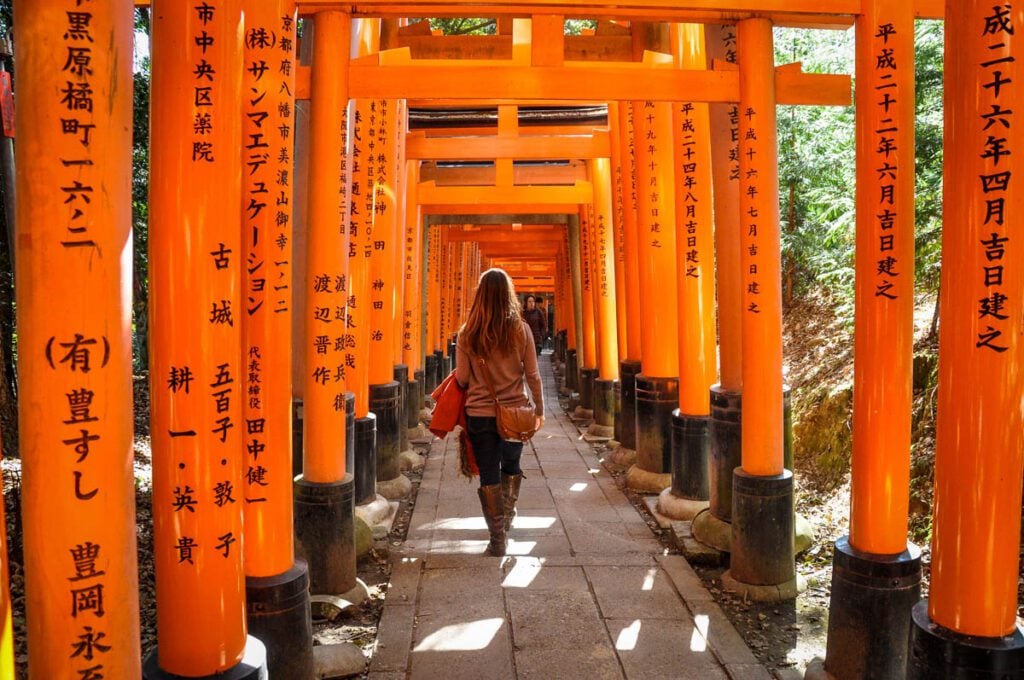
Fushimi Inari is perhaps one of the most iconic landmarks in Japan. While it is popular and nearly always crowded, it is well worth a visit.
Located just south of Kyoto, Fushimi Inari Taisha is dedicated to Inari, the Shinto god of rice. This shrine is famous for the thousands of orange torii gates under which a path snakes its way through thick forests and up the sacred grounds of Mount Inari.
In a word, Fushimi Inari Shrine is magical. To truly appreciate the grandeur of this place, you need to experience it yourself. Once you’ve walked through what seems to be a never-ending tunnel of orange gates as sunlight streams between, you’ll agree that this place is special.
But before you pack your bags, there are some things you should know about visiting to make sure you have a great experience.
We have personally visited Fushimi Inari Shrine twice, and we gathered all our best tips to help make your visit amazing.
Fushimi Inari guide
In this article, we’re breaking down the best time to visit, what to expect on the hike, hidden gems nearby, and things you should bring with you.
Click the links below to get answers to your questions quickly, or continue scrolling for everything you need to know about planning your visit to Fushimi Inari.
- Overview
- Fun facts & history
- Map
- Things to see at Fushimi Inari Shrine
- How to get there
- Best time to visit
- Fushimi Inari Hike
- Tips for visiting
- What to pack
- Where to eat
- FAQs
→ Psst! If your itinerary only allows you a limited amount of time in Kyoto, we’ve come up with the perfect 2-day route that will allow you to see top sights like Fushimi Inari, as well as some hidden gems. Check out our 2 day Kyoto itinerary for all the details!
Fushimi Inari overview
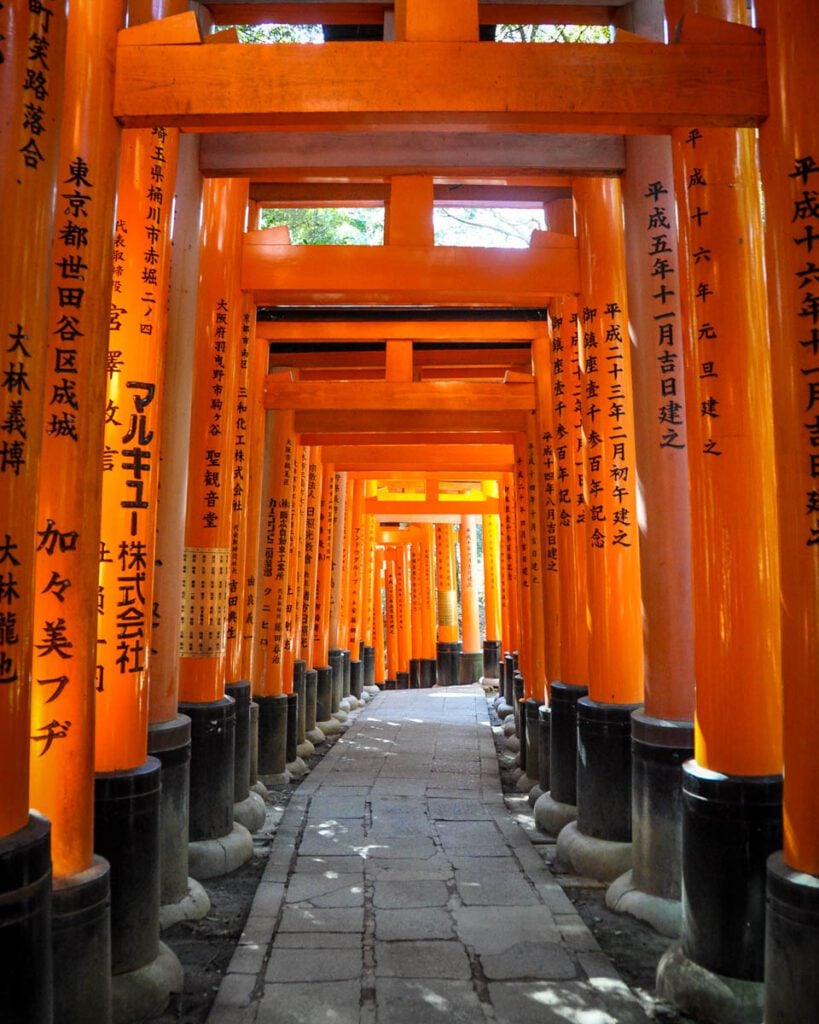
- Hours: Open 24/7
- Entrance fee: Free
- Location: Just outside Kyoto | Google Maps Location
- Time needed: 2-3 hours
- Best time of day: Early morning (7 a.m.) or after dark
- Child friendly? Yes
History & Fun facts
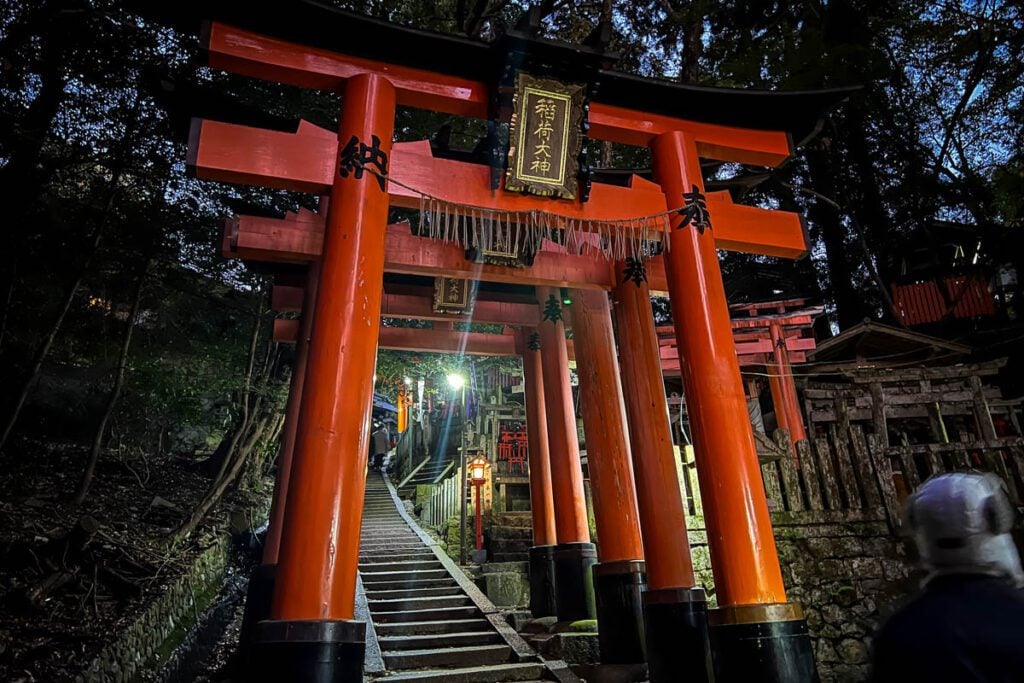
Fushimi Inari Shrine has ancient roots and is steeped in history. You’ll definitely want to read up on it before your visit to get the most out of your experience.
Here are some interesting bits of history and fun facts about this shrine:
- It is called both Fushimi Inari Shrine and Fushimi Inari Taisha interchangeably. Taisha means “grand shrine”.
- The first structures of Fushimi Inari Shrine were built in 711 (later relocated to their current location). Kyoto was Japan’s capital from 794-1868, meaning Fushimi Inari had begun to be built before Kyoto was such an important place.
- Mount Inari is 233 meters (765 feet) tall.
- Fushimi Inari is dedicated to Inari, the Shinto god of rice.
- There are roughly 30,000 shrines dedicated to Inari around Japan, but Fushimi Inari Taisha is the most important.
- You will see many fox statues throughout this shrine and along the paths. This is because foxes are the messengers of Inari according to Shinto beliefs.
- In total, there are roughly 10,000 torii gates at Fushimi Inari, 800 or so of which straddle the main path.
- There are shrines along the trail where you can write a wish on a small wooden fox or torii “ornament”. You can then hang it with the thousands of others left here, or you can bring it home as a souvenir.
- The iconic gates of Fushimi Inari have appeared in movies, including the 2005 film Memoirs of a Geisha.
Map of Fushimi Inari Taisha
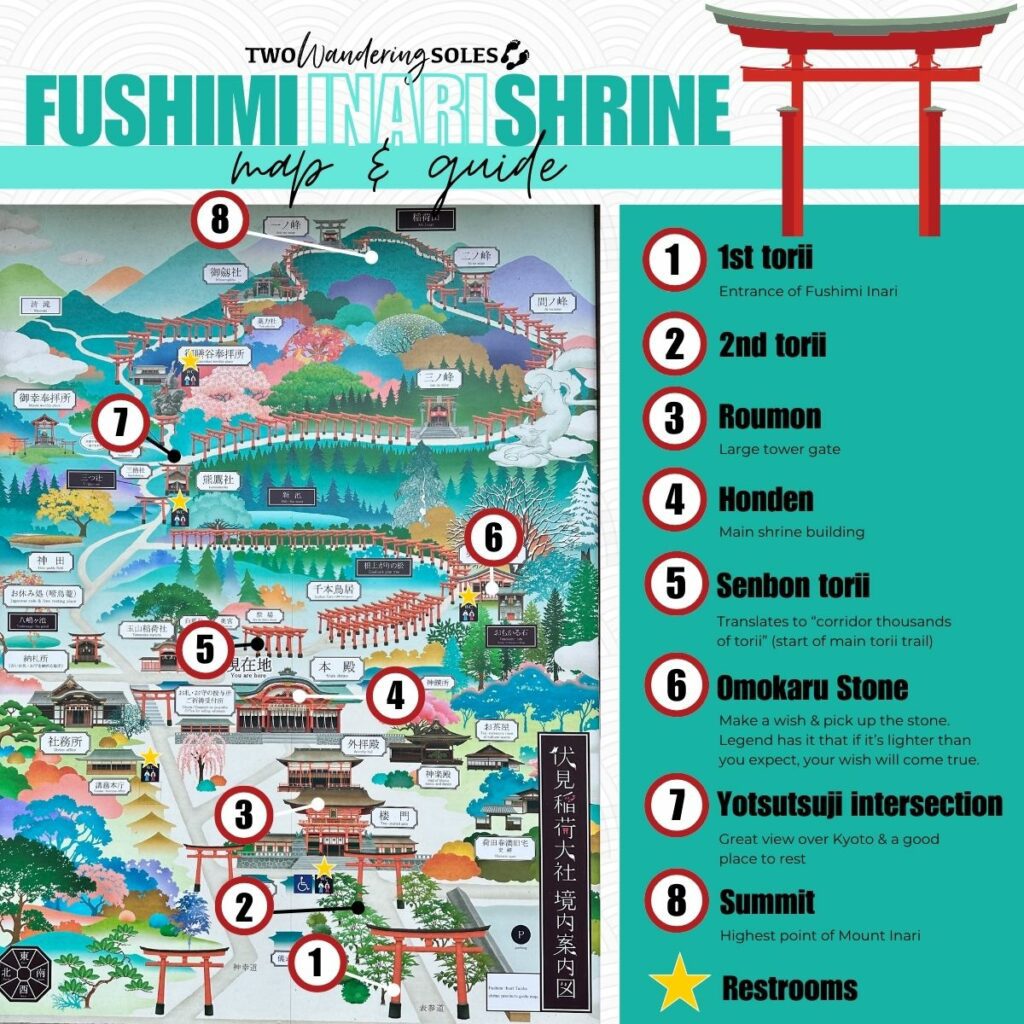
Save this map so you don’t miss anything during your visit to Fushimi Inari Shrine!
Things to do at Fushimi Inari Shrine
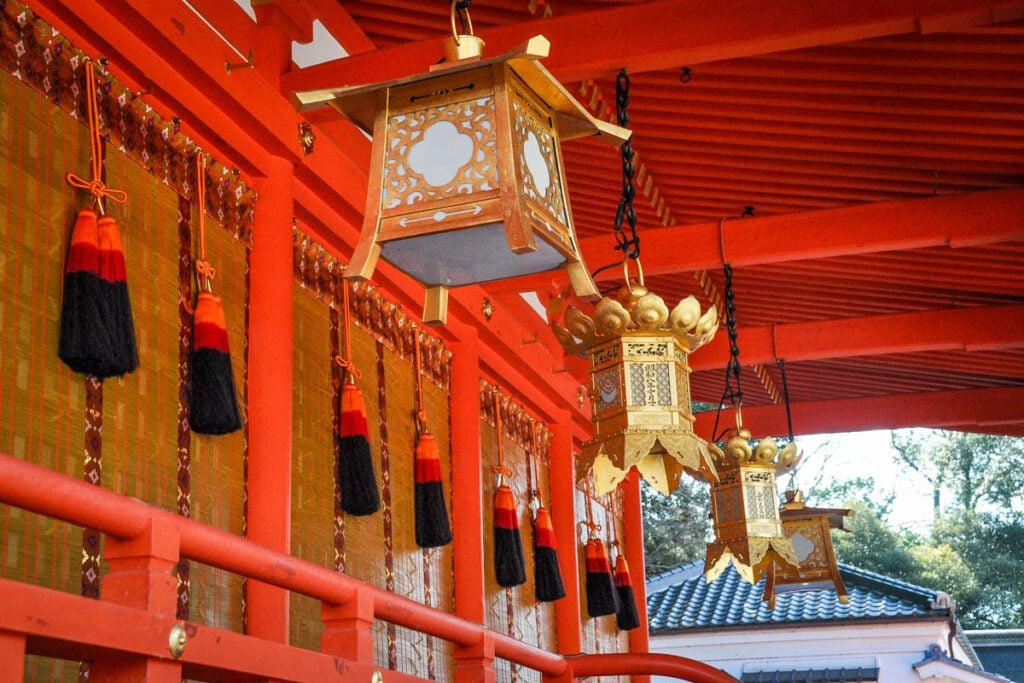
The shrine grounds are large and feature many things in addition to the iconic orange gates.
1. See the Haiden (worship hall)
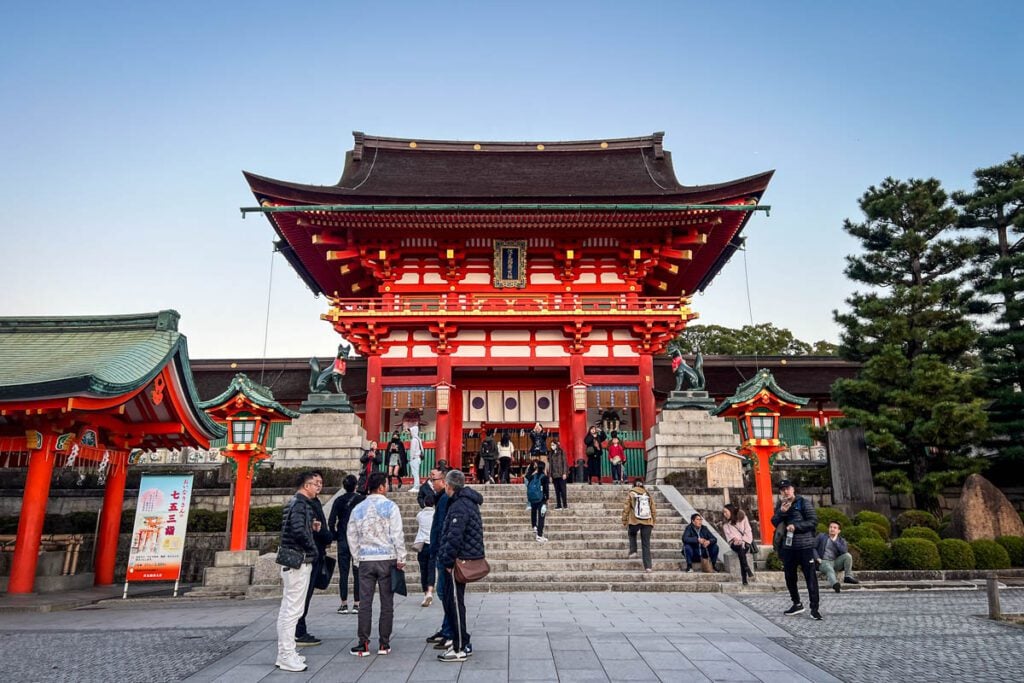
While most visitors come solely to see the torii, you will pass by the main hall when you enter Fushimi Inari.
There are a few structures, both for worshipers and for the gods. While beautiful, they are quite similar to worship halls at other shrines (at least from an outsider’s perspective).
Our advice: If you are trying to beat the crowds, we’d recommend taking a quick glance before continuing on up the trail. You can stop here on your way back down the path.
2. Walk under the orange torii gates
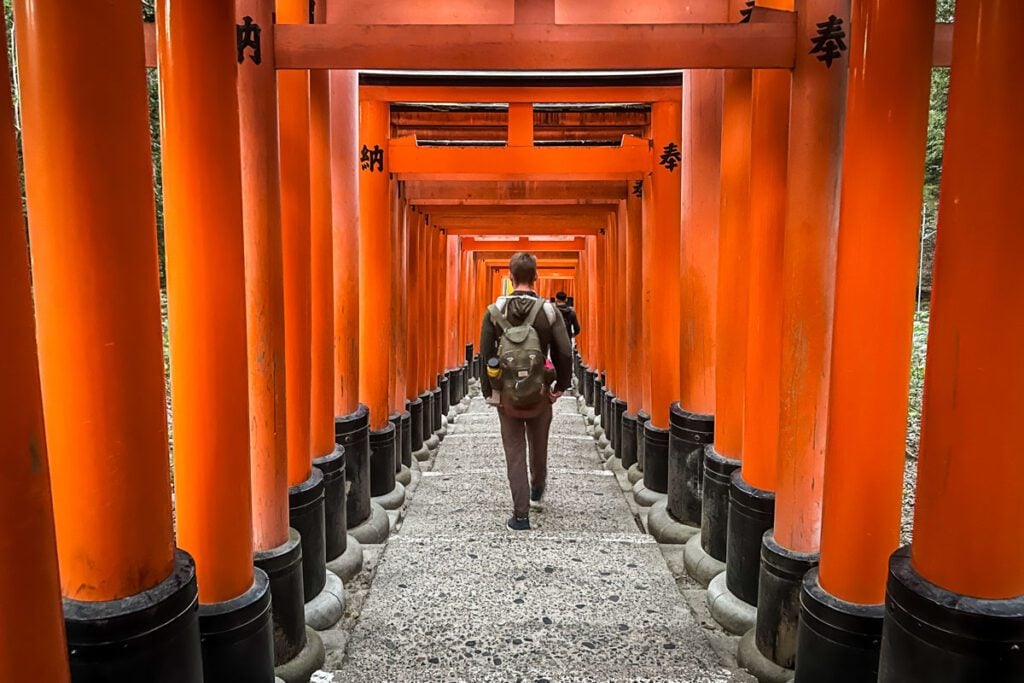
Okay, this is what you came for!
Fushimi Inari is most famous for the iconic orange gates that cover its hiking path. Before you go, there’s a lot you should know about torii and their meaning…
What are torii gates?
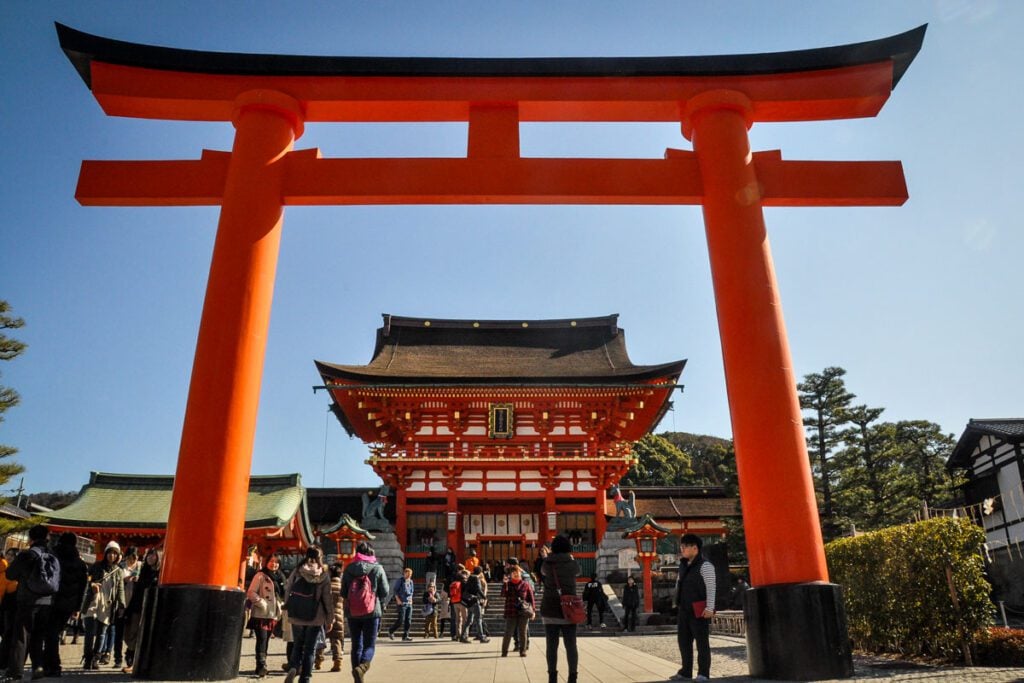
- Torii are traditional Japanese gates that you will commonly find at the entrance to or within Shinto shrines.
- They symbolize the transition from earth to the sacred world.
- Shinto religion says that kami, or spirits, travel through torii gates.
Fun fact: The trail is known as senbon torii, which translates to “corridor thousands of torii”, and refers to the tunnel-like pathway they create.
Why are these torii gates orange?
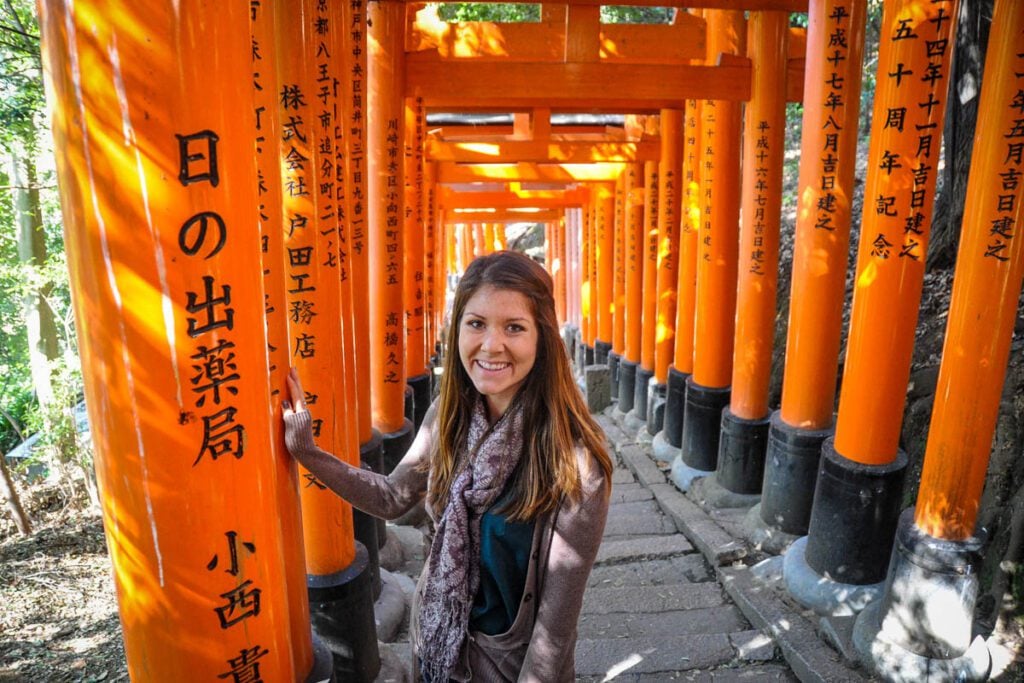
Well, let’s first get a little more technical… the specific shade of orange is vermilion, or in Japanese, shuiro.
This deep, red-orange was a very popular hue during ancient times, and the pigment was typically derived from a powdered mineral called cinnabar.
In traditional Japanese belief, shuiro is said to bring good luck and ward off evil spirits.
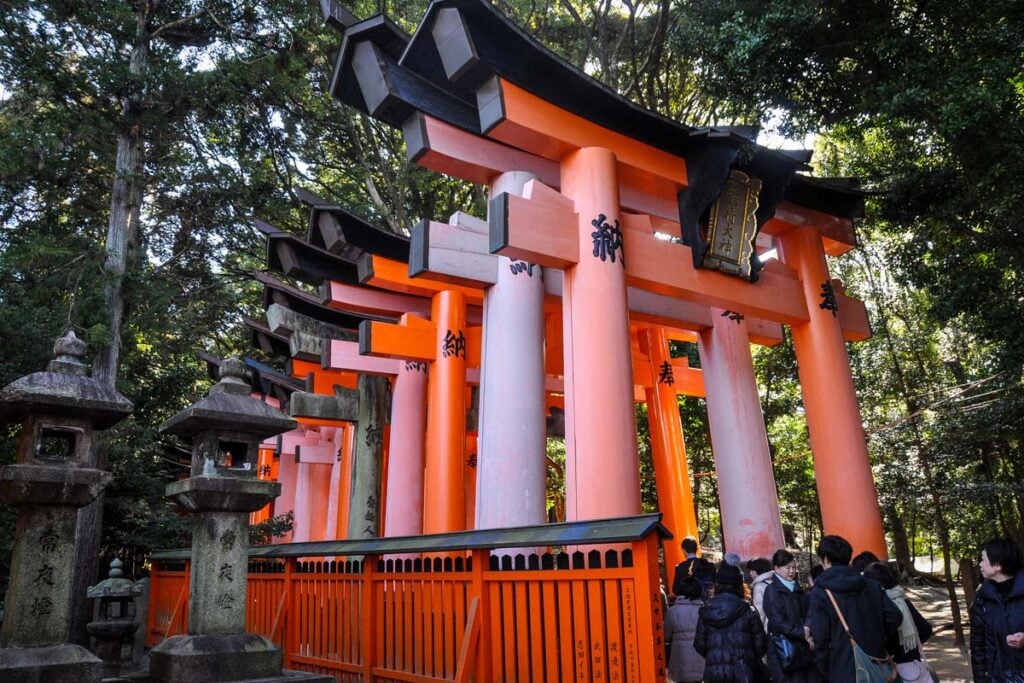
Good to know: You’ll notice that while the newer torii are a vibrant vermilion, some of the older ones are faded from sun-exposure and have almost a peach or pinkish hue. The variety of hues is one of my favorite details to photograph on the Fushimi Inari hike.
While vermilion torii are arguably the most iconic (even the emoji is this color!), they do exist in other colors elsewhere in Japan. One of the most famous examples is the natural wooden torii of the Meiji Shrine in Tokyo.
Why are there so many torii?
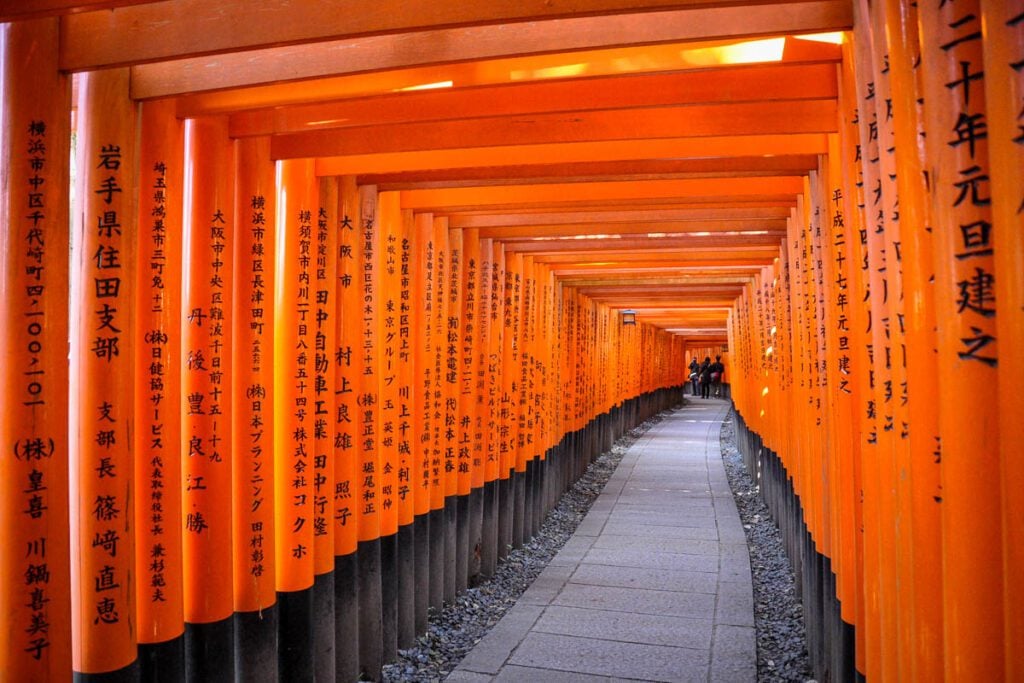
Each of the torii gates along the trail were donated by companies and individual people.
You will see Japanese characters carved on each torii. These inscriptions are the donor’s name as well as the date of donation.
Insider Tip: It’s kind of neat to get photographs facing both ways on the path. In one shot, you’ll get all the inscriptions and if you turn around in the same spot, you’ll get the gates without any writing for a totally different perspective.
How much do the torii cost?
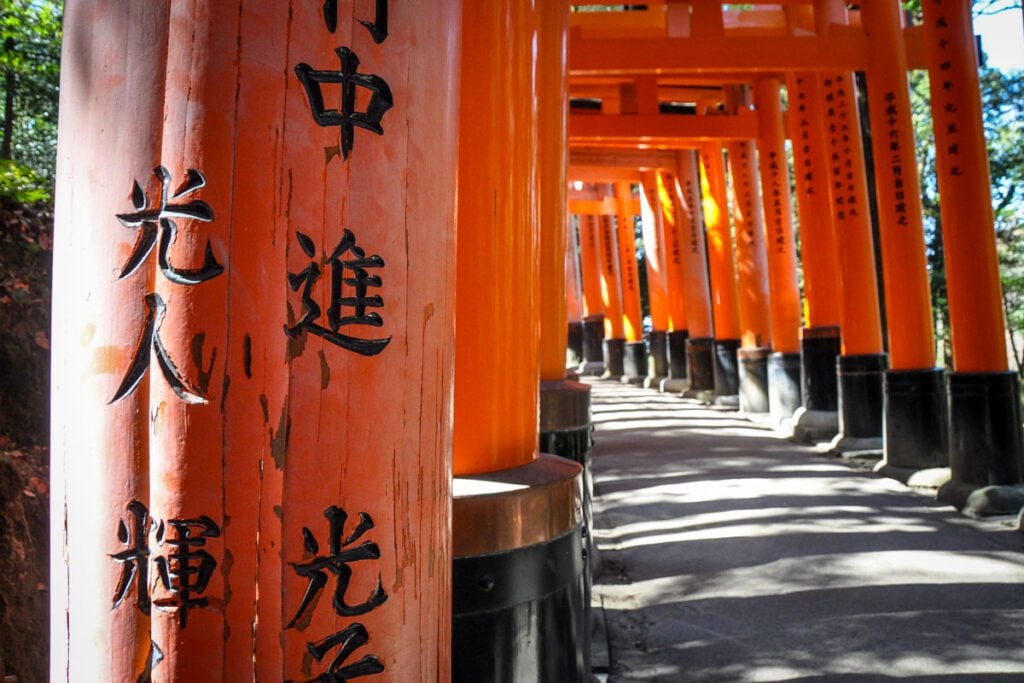
The torii gates range in price quite a bit depending on size:
- The smaller ones start at around ¥400,000 (around $2,600 USD).
- The larger ones can cost upwards of ¥1,000,000 (around $6,600 USD)
There are also much smaller symbolic torii around the grounds which presumably cost less to donate.
Can I buy a torii today?
Yes. People have been donating torii to the Fushimi Inari Shrine since at least the early 1600s (Edo era). Individuals and companies can still do so today.
3. Count as many Inari foxes as you can
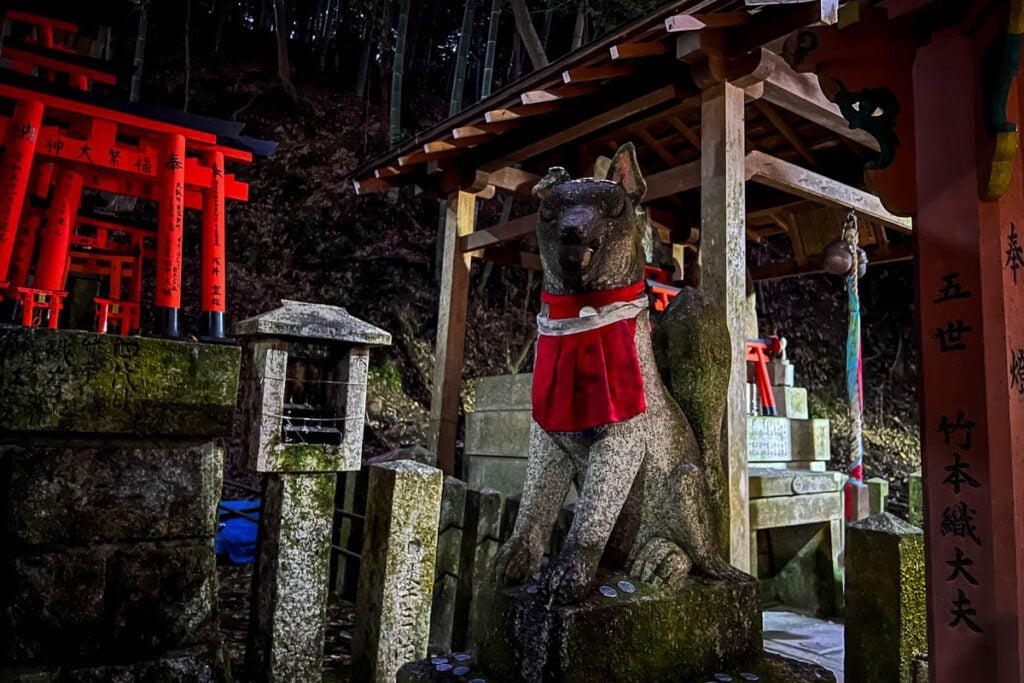
While exploring Fushimi Inari, you will notice lots of fox statues and souvenirs for sale. This is because foxes (kitsune) are said to be the messengers of Inari, the god of rice. For this reason, you’ll often find them at shrines dedicated to Inari.
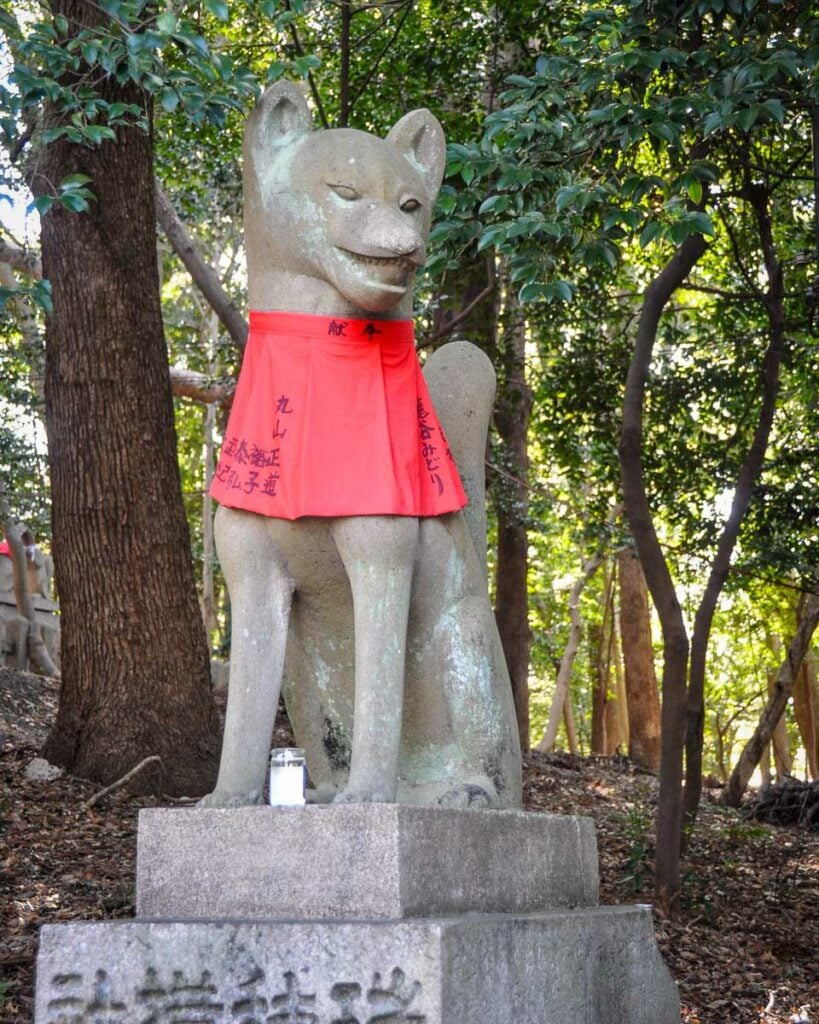
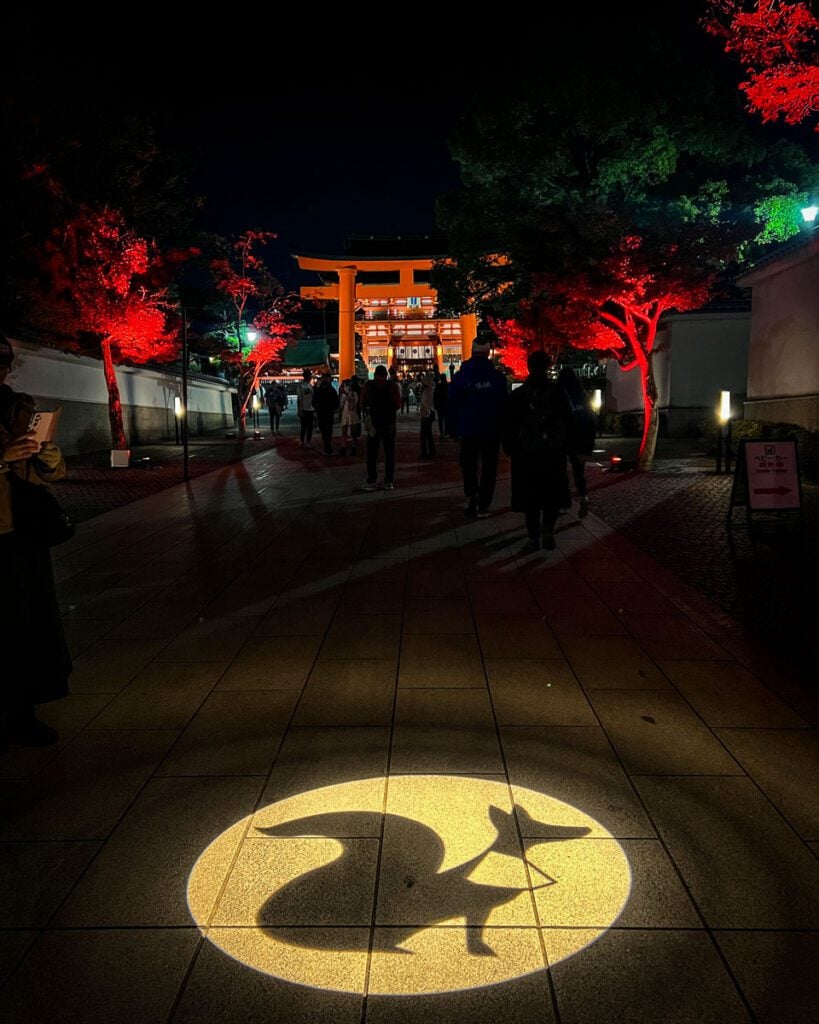
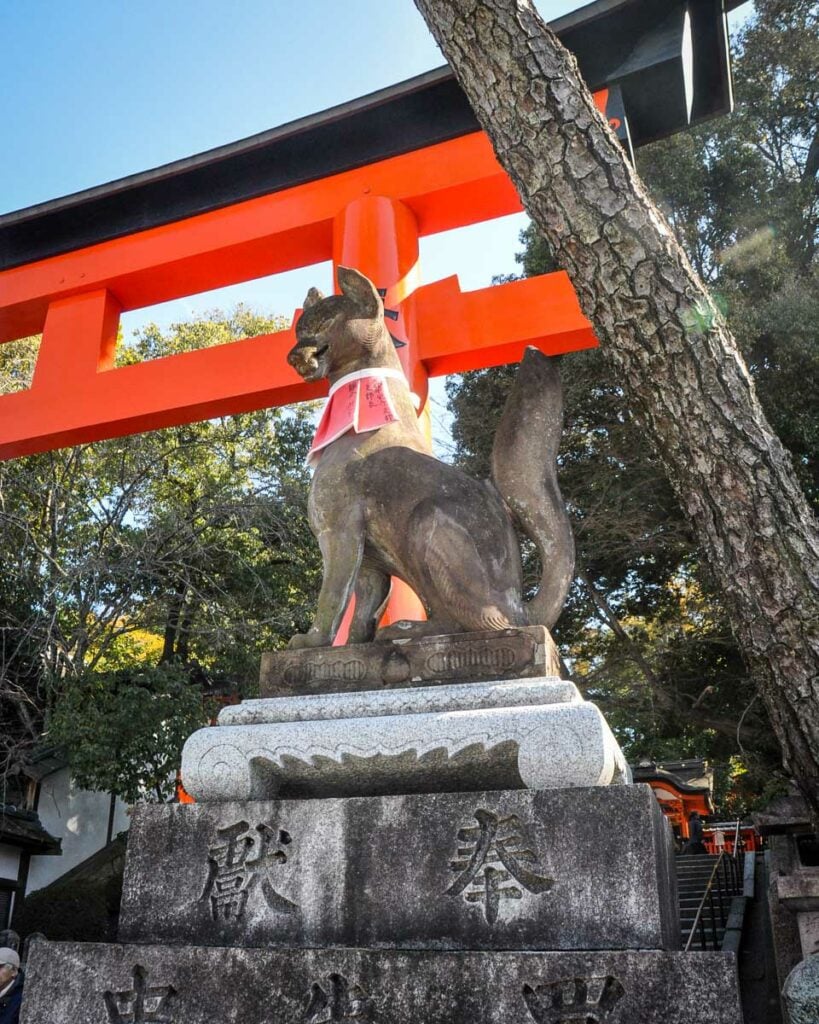
See how many fox motifs you can spot on your Fushimi Inari hike. (We lost count!)
Fun Fact: One feature you can look for on these fox statues is a key in their mouth. This is said to be a key to the rice granary.
4. Grab a bite to eat
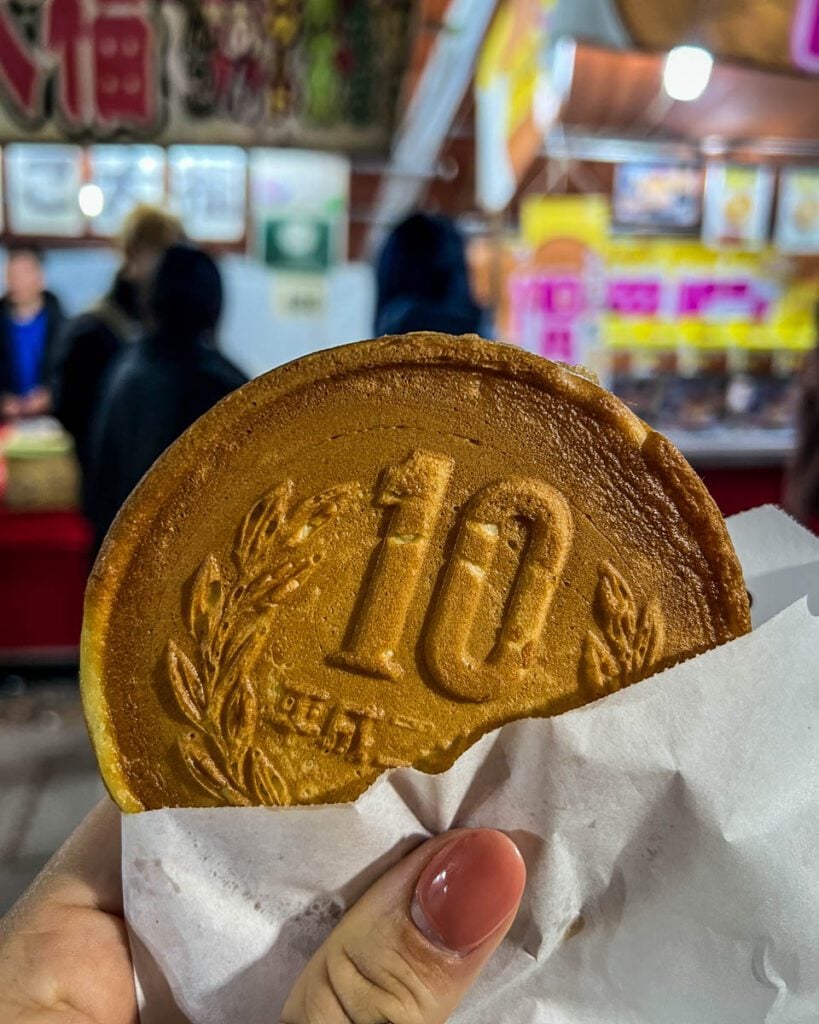
As you hike further up the path, you’ll notice a few small restaurants alongside the trail.
They are all pretty similar and offer themed dishes such as inarizushi and “kitsune (fox) udon”. No, it isn’t fox meat – both of these dishes highlight aburaage, which is fried tofu and said to be loved by foxes.
Personal advice: Unless you’re really hungry, we’d recommend skipping these restaurants and instead grabbing food at one of these places nearby.
In addition to these restaurants, there are also a handful of vending machines. We only saw machines with beverages, and the selection wasn’t great. We’d recommend bringing your own water, but if you run out it’s nice knowing you could grab one along the way.
5. Admire the view from Yotsutsuji intersection
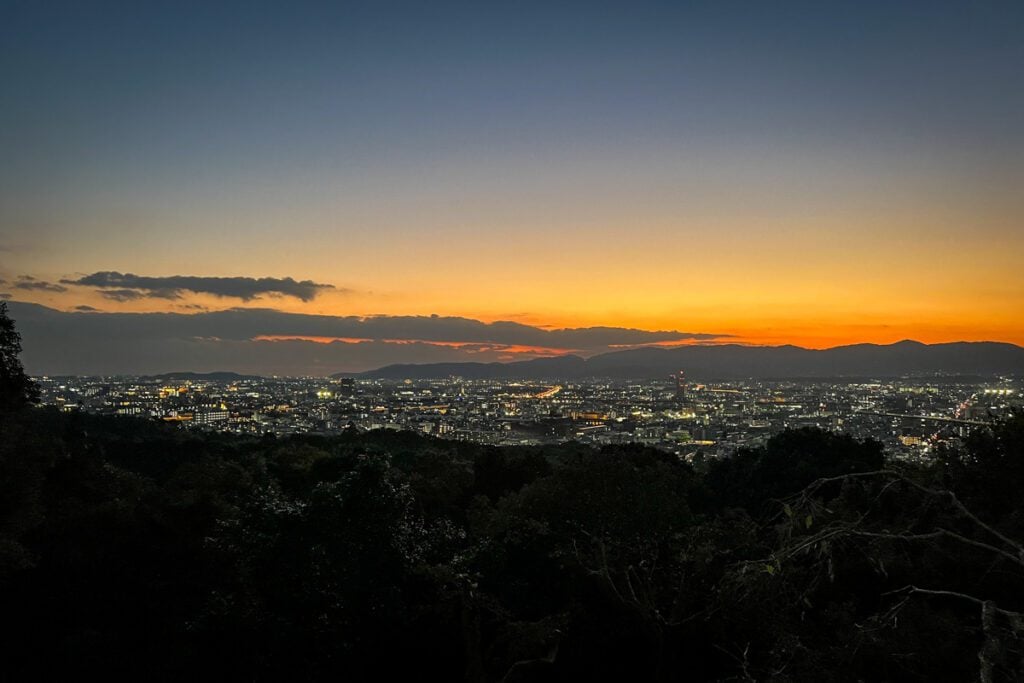
This is roughly the halfway point between the entrance and the summit of Mount Inari. It should take most hikers about 30-45 minutes to reach this point.
There is an opening in the trees and gates here, offering sweeping views over Kyoto. It is particularly beautiful at sunset.
This is a nice place to rest for a bit and enjoy a snack.
6. Climb to the Mount Inari summit
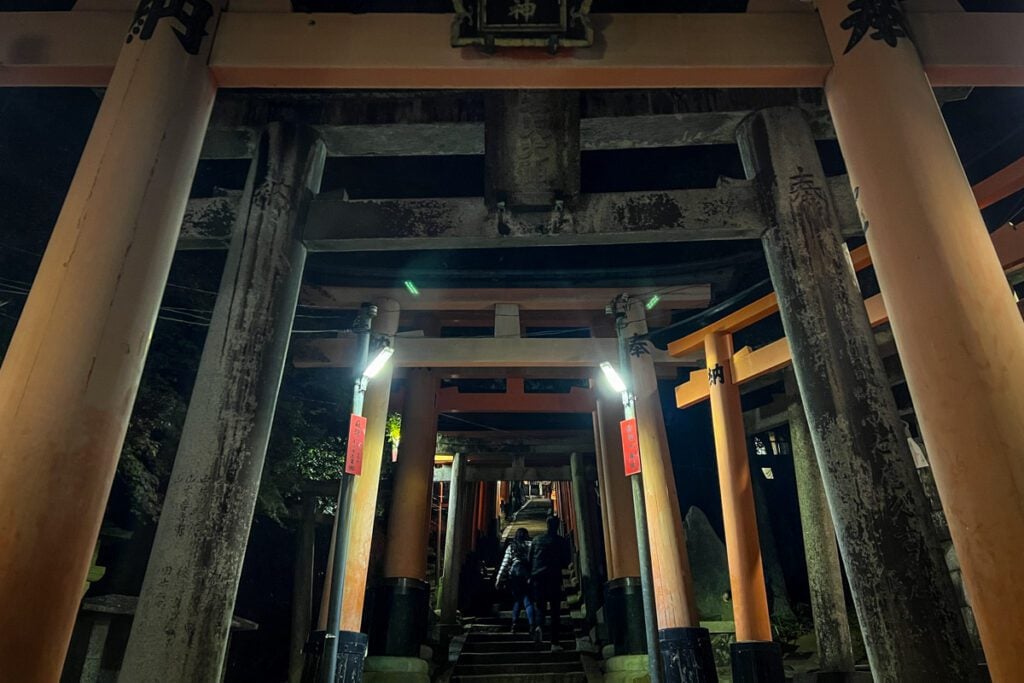
From Yotsutsuji intersection, you’ll notice the path continues on a pretty steep climb up to the summit of the mountain.
The gates are gradually more spread out, creating an entirely different atmosphere from the tunnel-like path up to this point.
There are also far fewer crowds here. You’ll even find tranquil bamboo forests in this section of the path. It is worth noting that while this will bring you to the top of the mountain, the best views over Kyoto are at Yotsutsuji intersection.
The path to and from the summit is a circular route and returns to Yotsutsuji intersection, from which you can descend to where you started.
How to get to Fushimi Inari Taisha
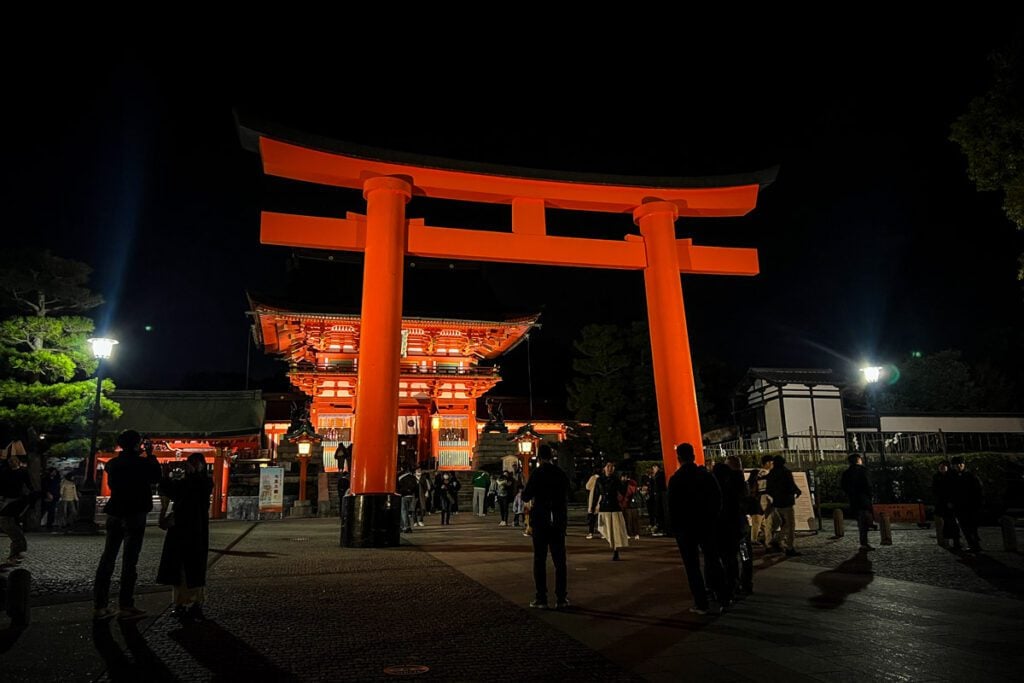
While Fushimi Inari is located just outside Kyoto city, it is very easy to get here:
Easiest option: Take the JR Nara Line from Kyoto Station. Ride the train for 5 minutes before getting off at JR Inari Station (the second stop). Once you exit the station, you will cross the street and you can’t miss the entrance to Fushimi Inari.
Alternatively, you can take the Keihan Main Line train to the Fushimi Inari Station. From here it is a short walk to the entrance.
Best time to visit Fushimi Inari Shrine
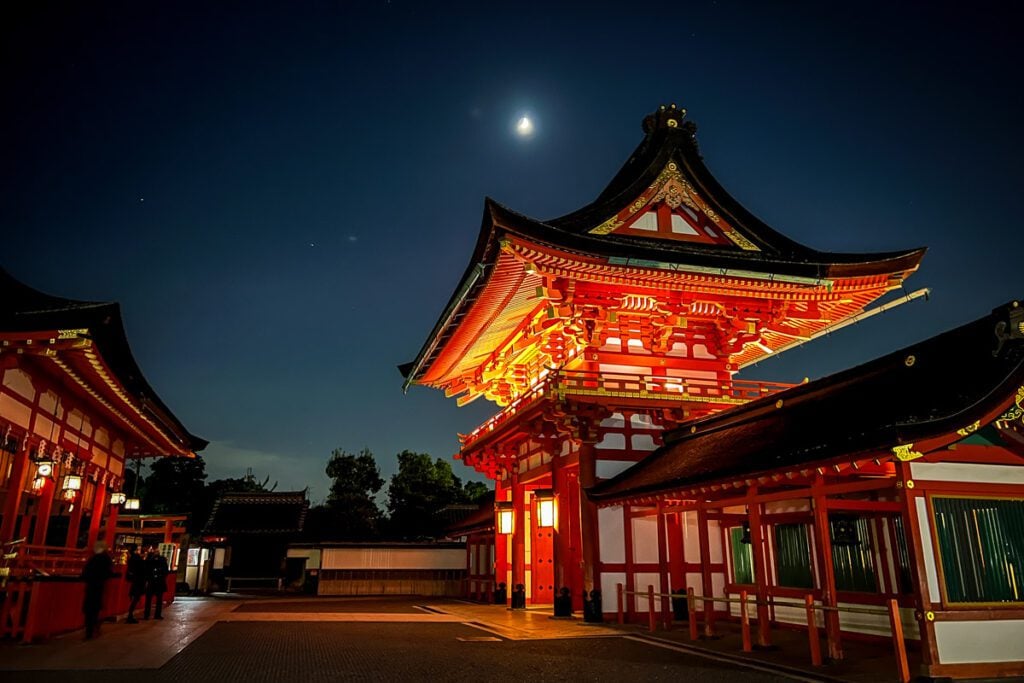
While each season has draws and drawbacks, Fushimi Inari really is lovely during all seasons. If you’re spending time in Kyoto, Fushimi Inari should be on your itinerary.
Read more about when is the best time to visit Japan.
- Summer: can be hot and humid with the possibility of heavy rains
- Fall: comfortable temperatures for hiking
- Winter: colder weather means it tends to be less crowded
- Spring: nice temperatures for hiking but spring is a popular season for travel in Japan, so expect crowds
What is the best time of day to visit?
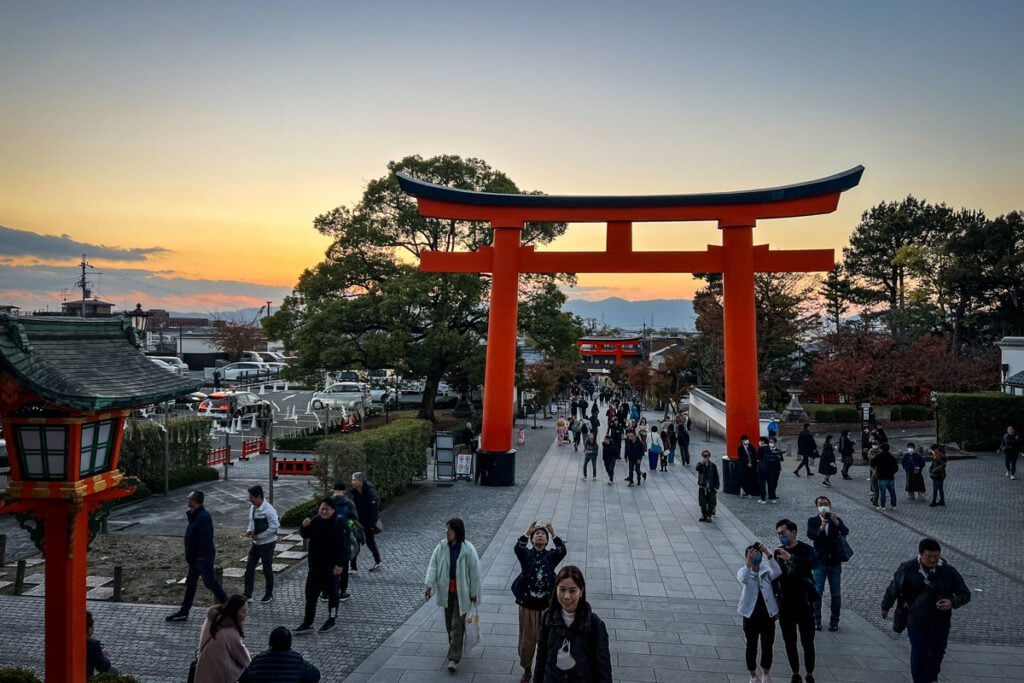
Very early morning is the best time to visit, and after dark is another good option.
Early morning
By many accounts, Fushimi Inari gets extremely crowded around 10 a.m. and I would actually say that by 9 a.m. it will be pretty busy.
If you can muster the strength to get out of bed early and arrive before or around 7 a.m., you will have a much better experience than later in the day. Trust me.
I’m not saying there won’t be other people there, because there most certainly will be. But it will be much, much less busy than just a few hours later in the day.
Lighting during the early morning hours is lovely and the lack of crowds will make it the best time of day to get a great photograph.
If early mornings aren’t your thing, you may want to visit (much) later in the day…
Sunset & after dark
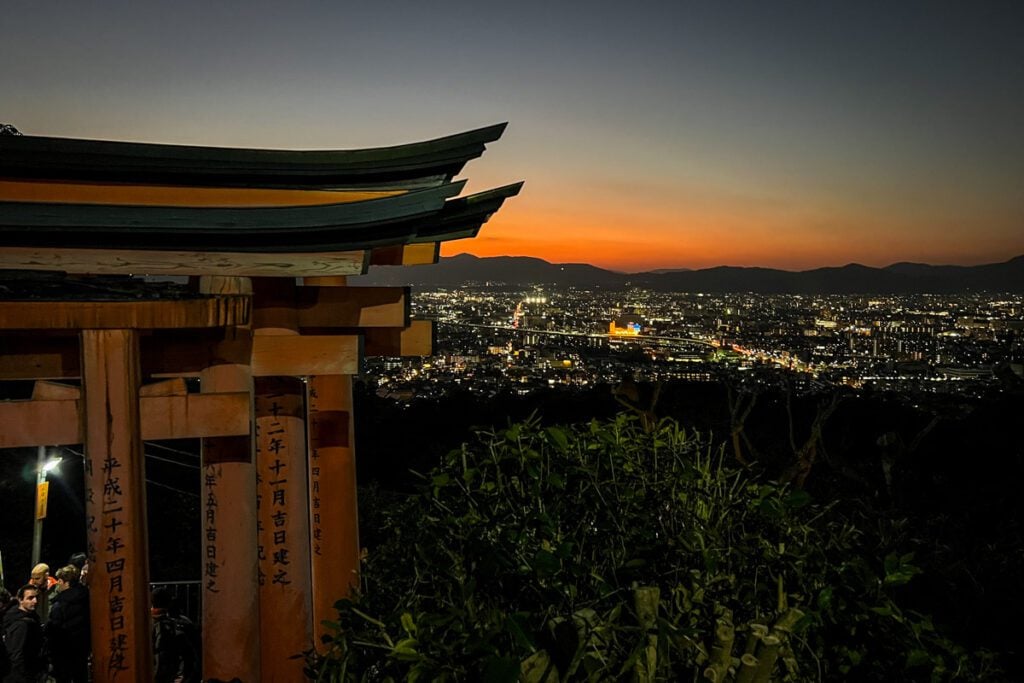
If getting there early in the morning doesn’t suit you, another great option is visiting in the evening.
We’d recommend arriving before sunset so you can see this place in the daylight. That said, sunset is a popular time and you should expect crowds.
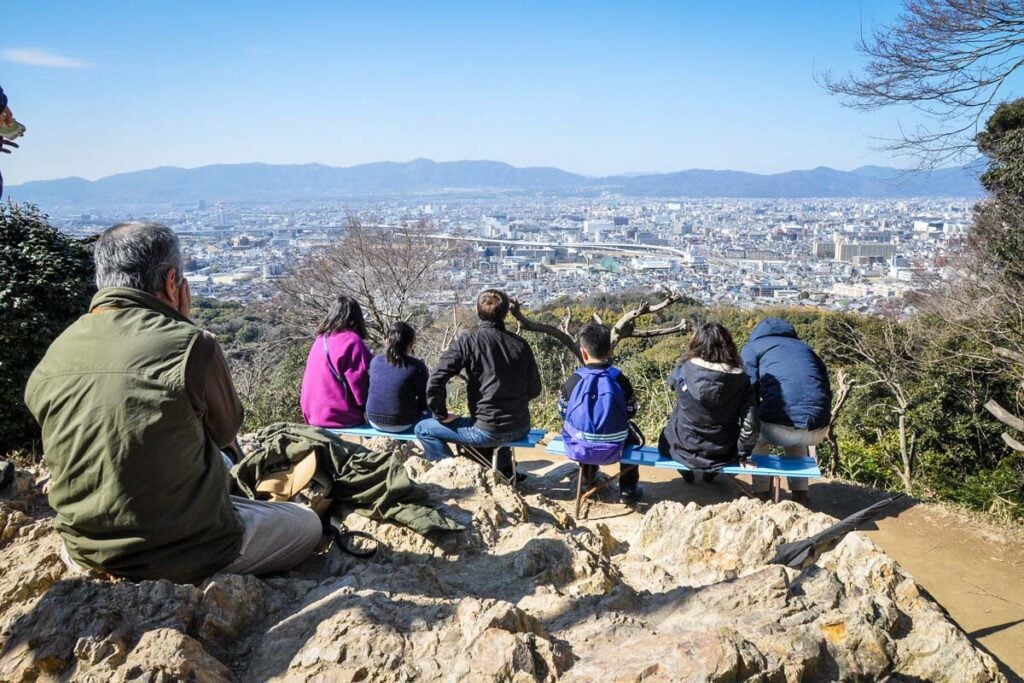
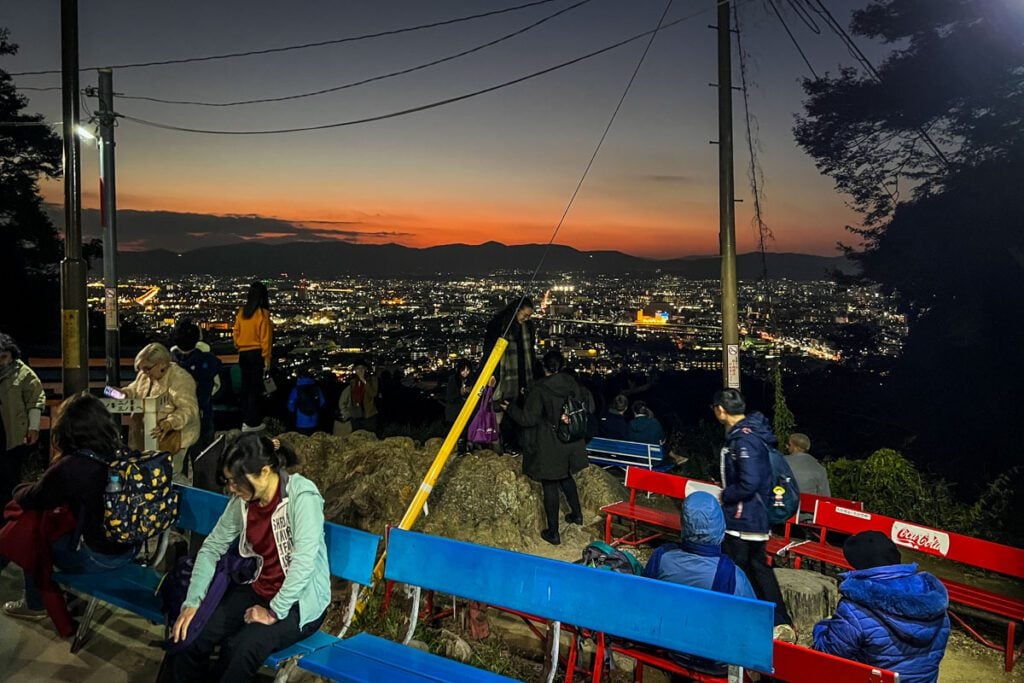
Once it starts getting dark, people clear out pretty quickly. This is when you can slow down and take your time. The atmosphere transforms from a buzzy place to a tranquil and dare I say almost eerie one (but not in a bad way!). It can be really neat to experience the transformation of these sacred grounds and see it shift from glowy sunset to darkness.
Our advice: If you plan to come in the evening, combining this with a day trip to Nara makes an excellent day. This is what we personally did!
When to avoid (if possible): Midday
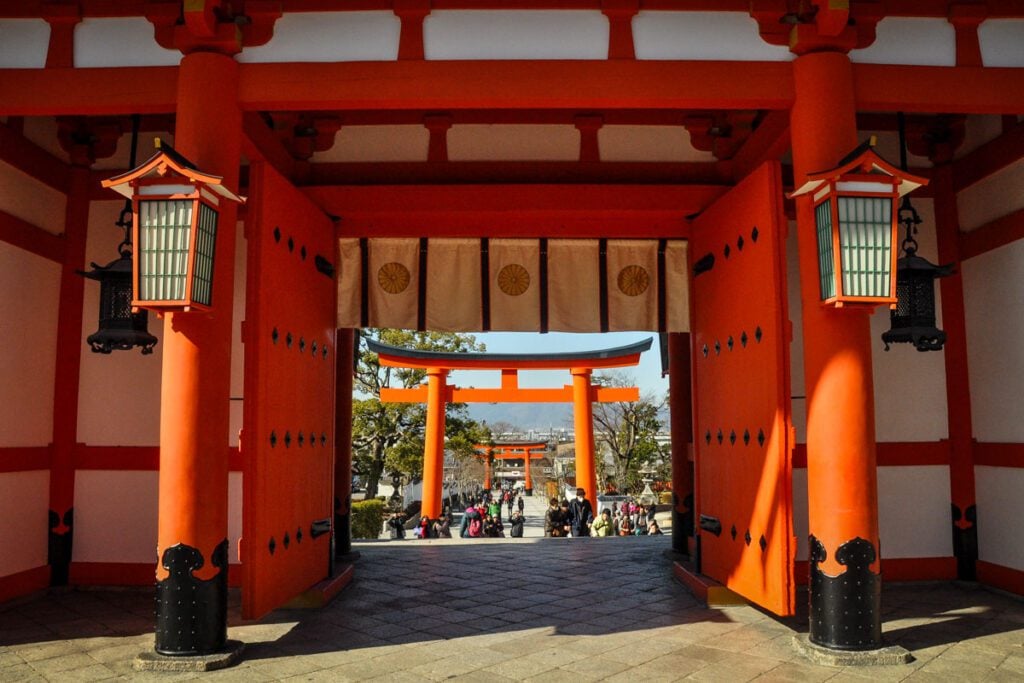
If at all possible, we would not recommend planning to visit Fushimi Inari during midday as it gets incredibly crowded.
This means the trails will be backed up and there will more or less be a line for much of the way. Additionally, it will be nearly impossible to take a good picture with all the people around, plus, the midday lighting is harsh for photos.
Fushimi Inari Hike
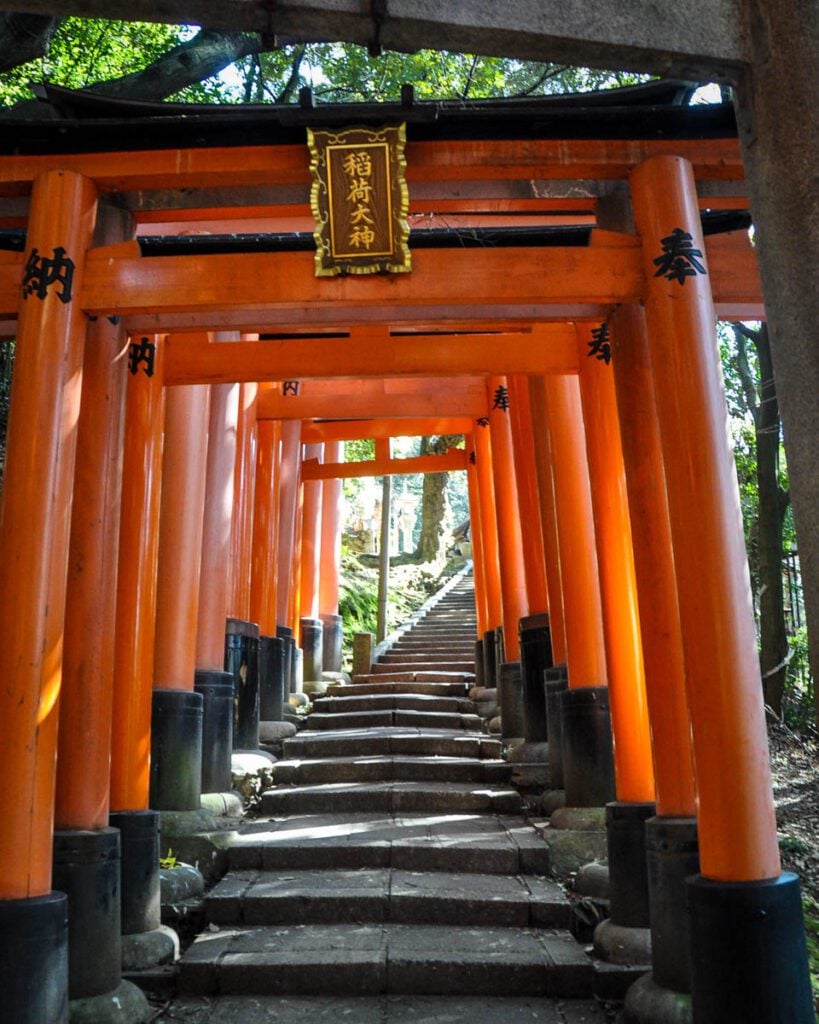
Now, this isn’t your average hike…
Vermillion torii gates straddle the trail that leads up Mount Inari, creating the illusion of walking through an orange tunnel.
- Distance: 2.8 miles / 4.5 km total (you can turn around early if you’d like)
- Elevation gain: 550 feet / 168 meters
- Difficulty: easy to moderate
- Trail notes: Truly, you can’t lose the path – you just follow the gates, silly! But in case you want to see what the route looks like, here is the AllTrails map and notes.
Good to know: The path is mostly made of stone and there are steps along the way, making it not very suitable for wheelchairs or strollers. If you are using a stroller, however, we have a hot tip for you!
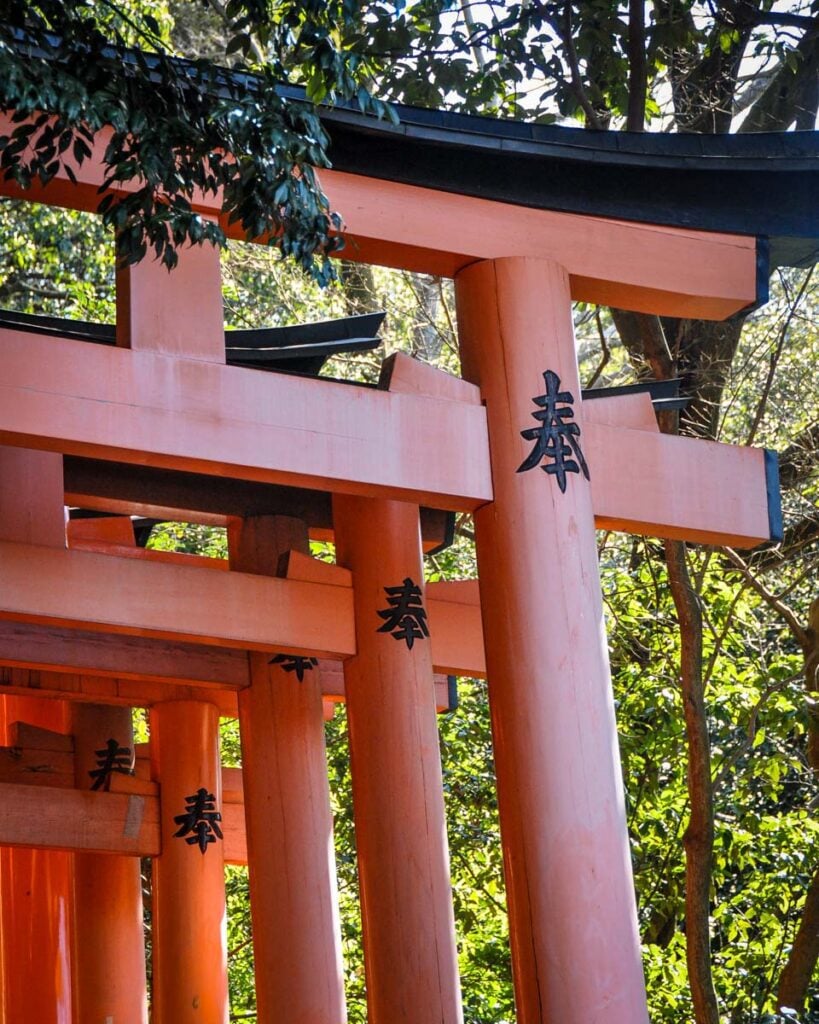
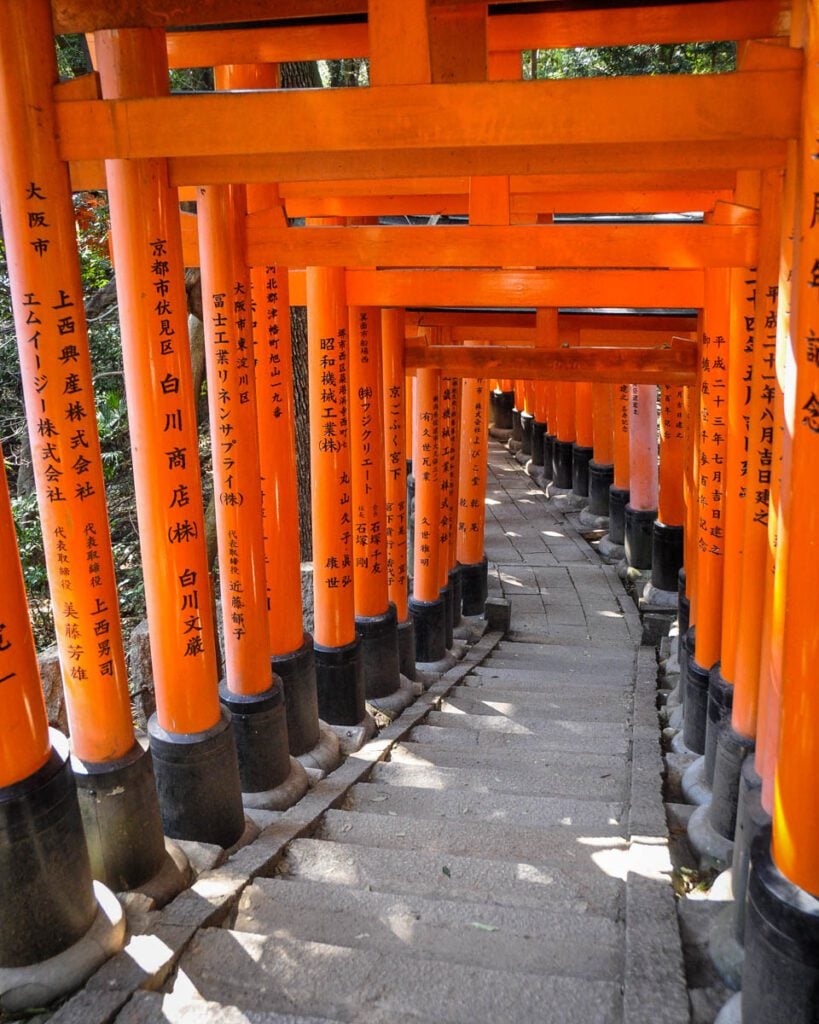
The path is easy to follow, and brings you past several small shrines. Midway through the hike, there is a lovely viewpoint over Kyoto.
From here, you can turn around and return to the beginning or complete the hike by continuing up the stairs to the summit of Mount Inari.
Are your dogs barking after climbing all those stairs? This foot spa is located near the entrance of Fushimi Inari and offers 30-minute (roughly $33) and 50-minute (roughly $47) treatments that include a foot soak and massage, which would feel heavenly after long days of walking in Japan!
Tips for visiting Fushimi Inari Shrine
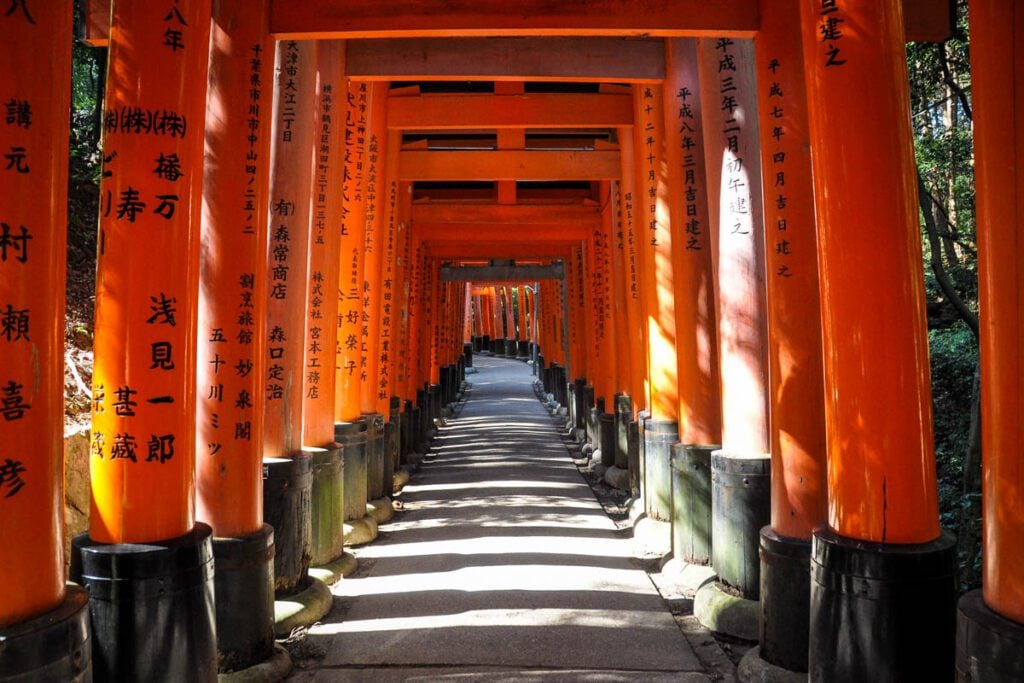
Here are our top pieces of advice for making your experience at Fushimi Inari Shrine a good one:
1. Backwards plan your timing
We’ve already discussed that the best time of day to visit is early in the morning or evening time. But we know it can be difficult to get places as early as you’d like in Japan unless you really plan ahead.
Look at the train times and then determine what time you’ll need to leave your hotel. If you’re going early in the morning, set several alarms and pack your bags the night before.
2. Be prepared for the hike
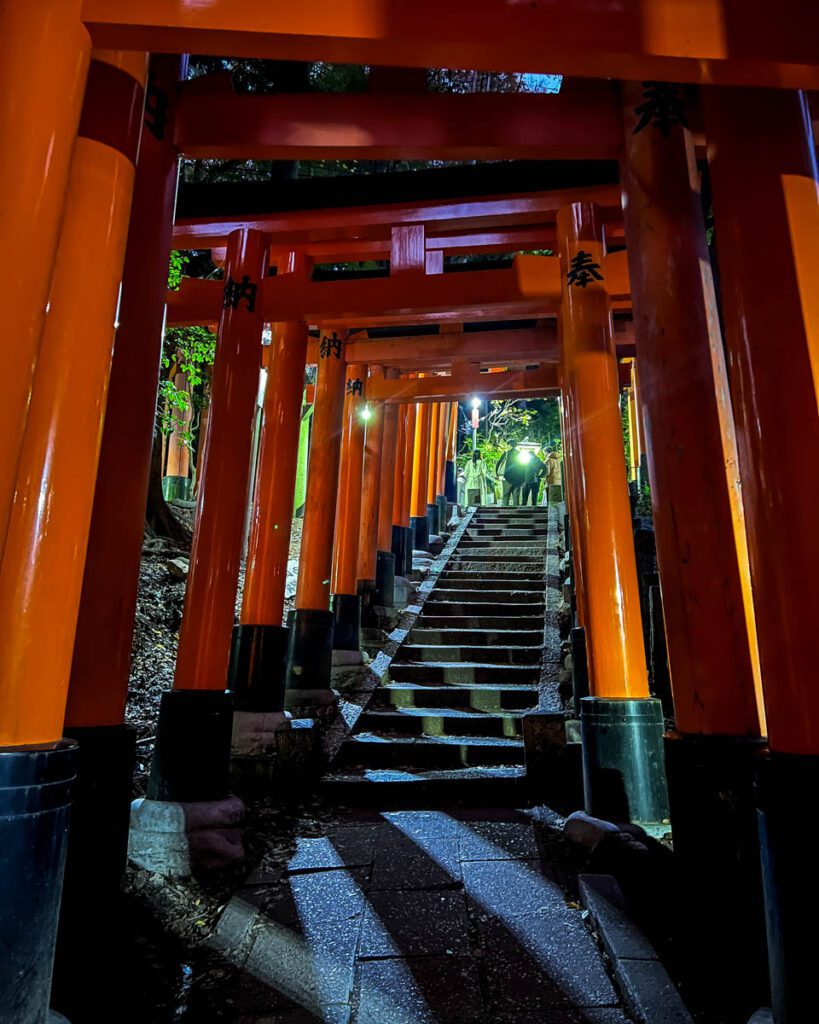
I don’t know about you, but there’s nothing worse than being mid-hike and getting cold. Or hot… or hangry… or all of the above.
Pack plenty of snacks and water, and wear comfortable clothes and shoes. You will be walking uphill for quite some time.
3. Be patient
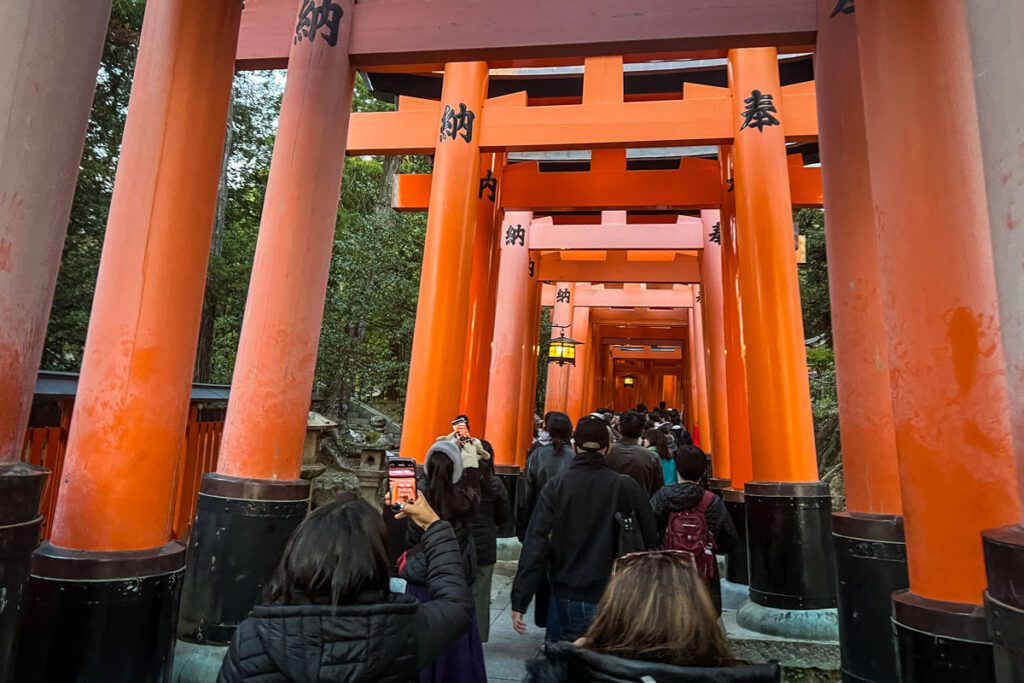
Unless you’re here at the crack of dawn (and sometimes even then), you will have to share the trail with others. Sometimes lots of others. Be patient and kind. Everyone is here for the same reason.
If you really want to get away from people, walk at a fast pace until you pass the Yotsutsuji intersection where the crowds really thin out.
4. Think about where you’re setting up your tripod
While it is possible to set up a tripod here, really think about where you’re doing it.
In the really crowded sections, it can be pretty rude to set up shop since you’d be blocking the path and in the way of everyone else’s shots.
There are definitely areas that are less crowded that make good places to set up your tripod. Plus, if you come really early, you can be assured there will be less people around.
Psst! Don’t miss these creative and easy-to-follow tips for travel photography.
5. Give yourself enough time
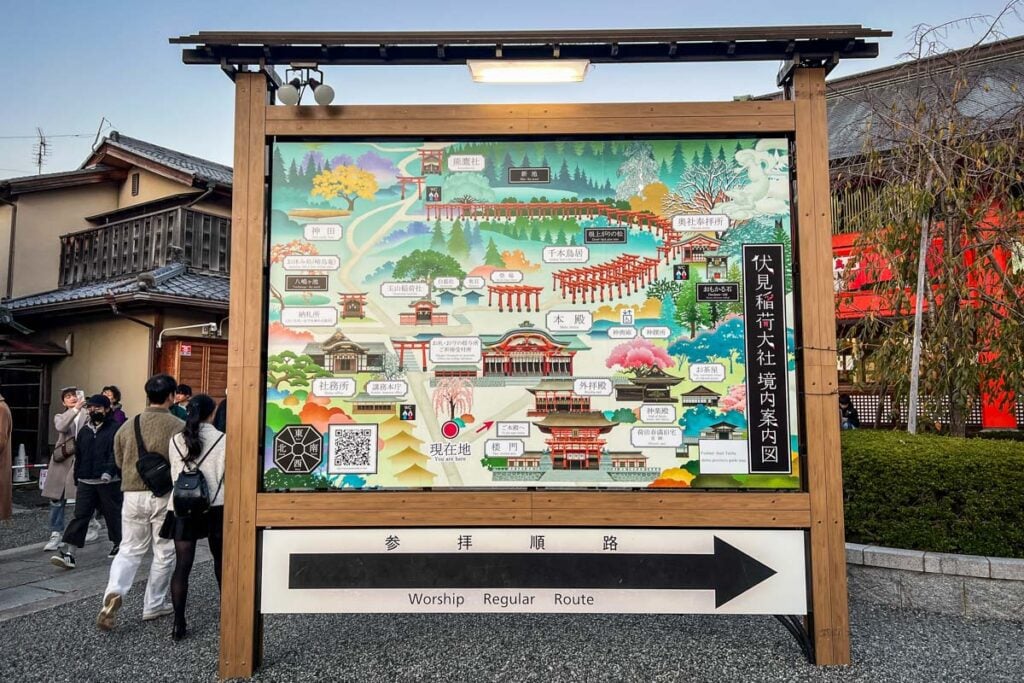
This is a bucket list place and you want to be sure you’ve devoted enough time to fully seeing it. You won’t want to feel rushed (especially when there are stairs involved!).
6. Decide if you want to buy souvenirs
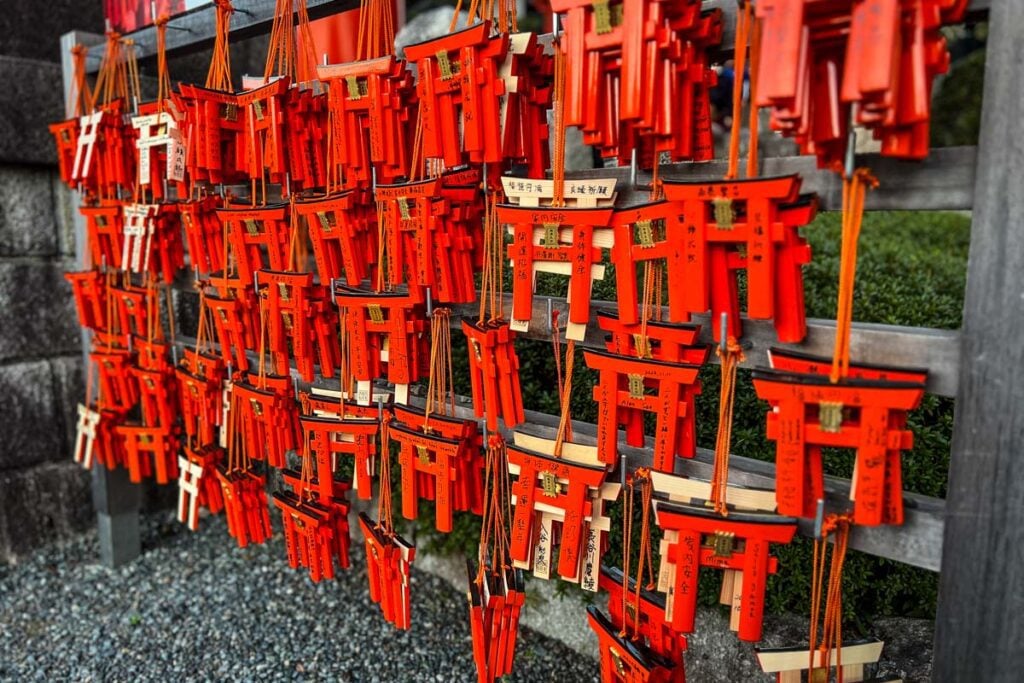
There are a couple small souvenir shops near Fushimi Inari. Plus, you can buy a small replica of the tori gates from the shrines. Instead of hanging it with all the rest, you can bring yours home.
Psst! Here are more ideas of what to buy in Japan.
Our personal experience at Fushimi Inari
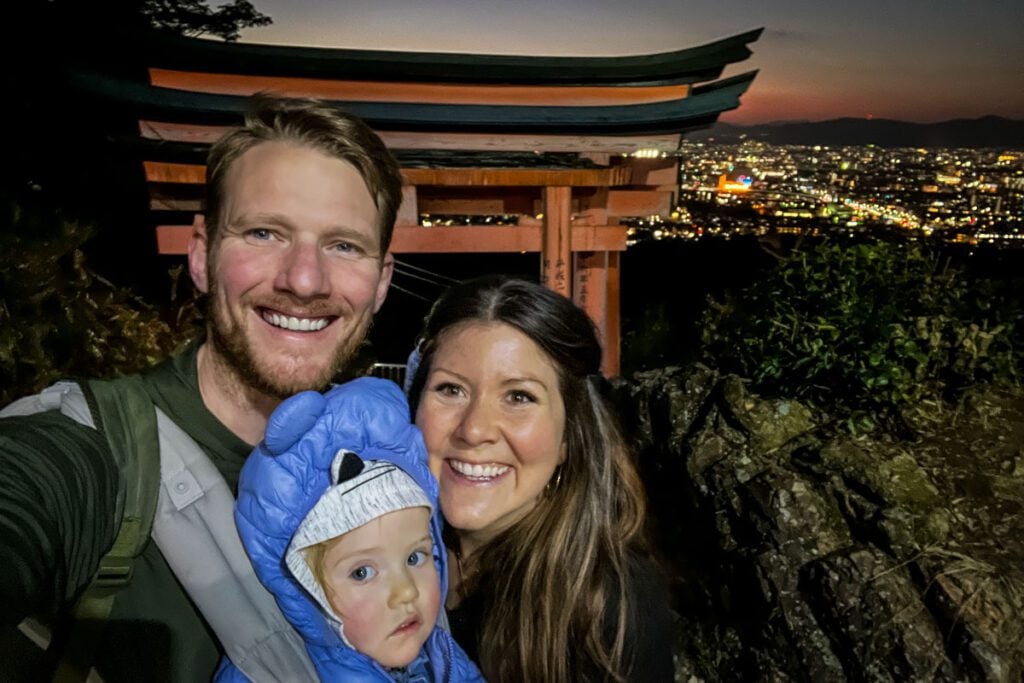
I first remember seeing Fushimi Inari Shrine in my Asian art history class in college, and ever since I have been fascinated by this pathway covered in orange torii gates that snakes its way up a mountain.
We have been to Fushimi Inari two times, and both were quite different experiences:
- 1st visit (2015): during the winter, we arrived early in the morning
- 2nd visit (2023): during autumn, we arrived around sunset (after taking a day trip to Nara), and we had a toddler with us
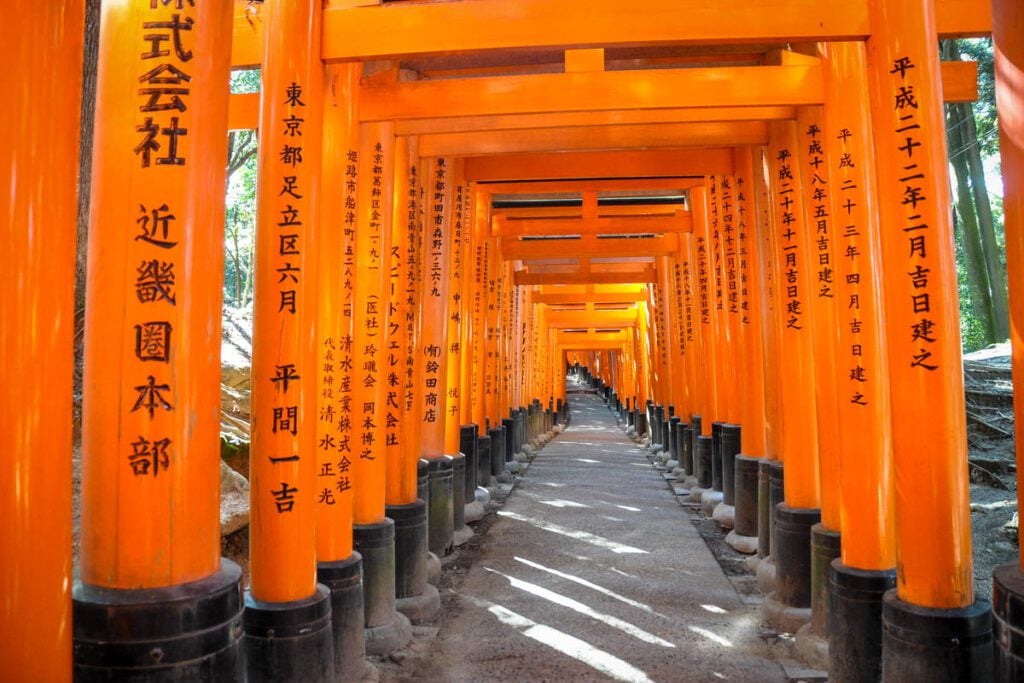
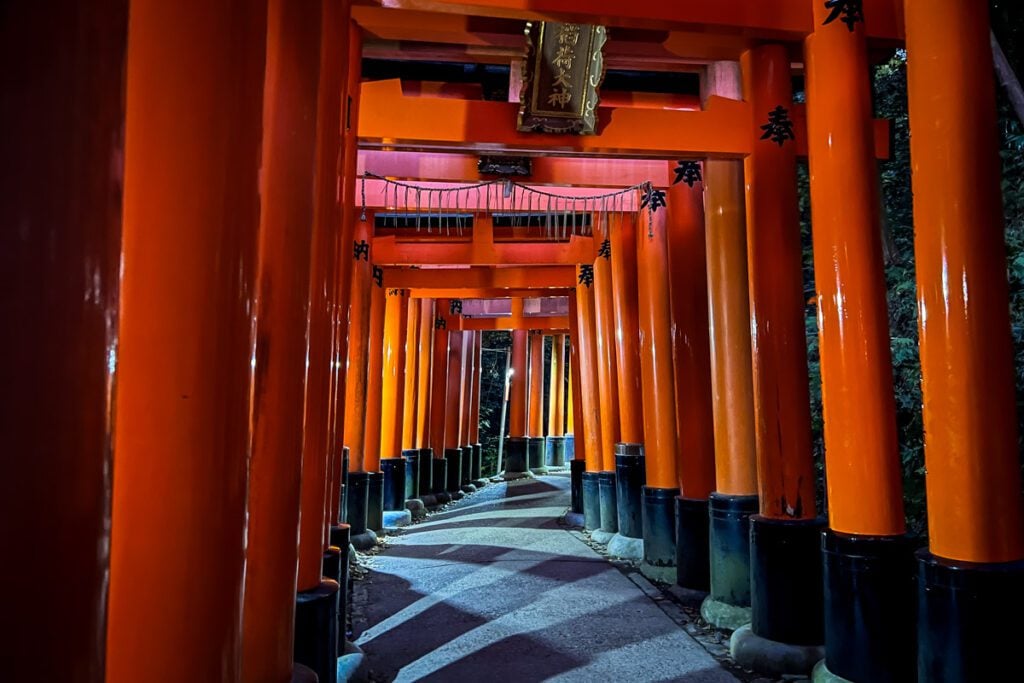
Both times were truly memorable and solidified for me that this place is incredibly special. Some major attractions are not worth the hype, but this is not one of those places.
What to pack
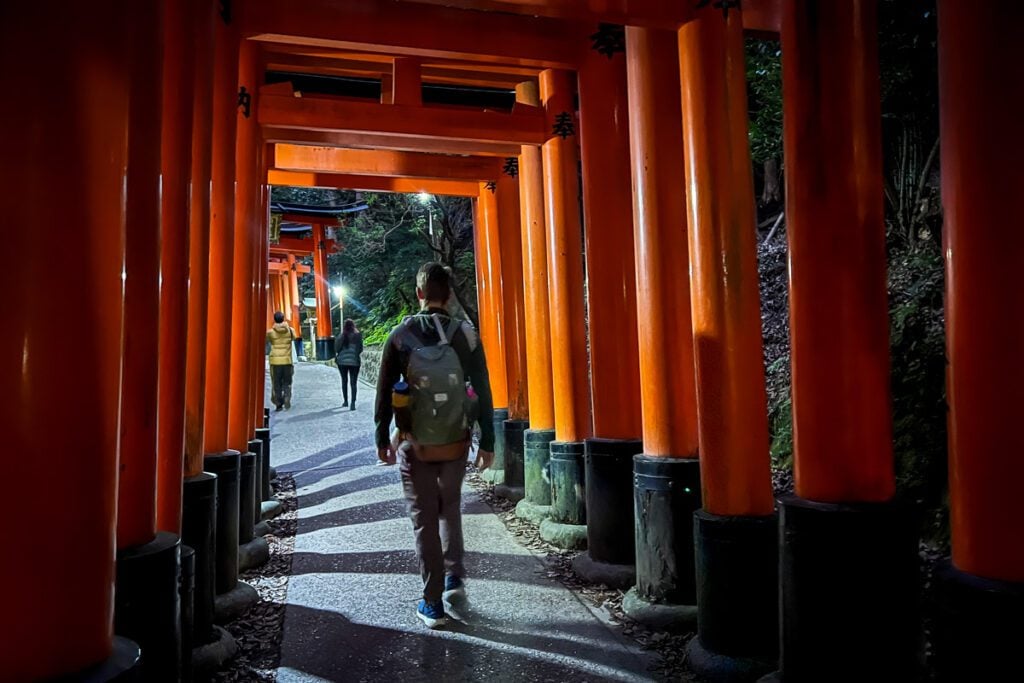
While I don’t think you need all that much for visiting this shrine, there are a few important things to pack.
- Daypack: Having a small backpack will be a good way to carry your belongings.
- Water: Since you’re hiking and spending at least 2 hours here, you’ll definitely need water. I would add that you’ll need even more in the hot and humid summer months.
- Snacks: It’s a good idea to have a couple of snacks in your backpack in case you work up an appetite. Nobody wants to be hangry in such a beautiful place! Just be sure you don’t eat while walking as this is considered rude in Japan. Stop off the trail if you’d like to take a snack break.
- Layers: Look ahead at the weather and wear appropriate layers that can be easily removed if you get too hot.
- Photo equipment: If you’re into photography, you’ll want your camera (and maybe even a tripod) for this place. It’s worth noting that phones can capture really amazing photos here too.
- Flashlight or headlamp: If you’re visiting in the late afternoon or evening, you’ll want to have some light source. Many hotels in Japan have flashlights, so you could borrow it. Alternatively, you can use your phone flashlight, but know that will drain your battery.
- Battery pack: You won’t want to run out of battery on your phone while in such an incredible place. You’ll likely be using the internet, taking photos, and maybe even using your phone’s flashlight, all of which use power. Bring a battery pack just in case! (This one is our favorite!)
- Comfortable shoes: Wearing comfy shoes is a must, as you’ll be clocking in lots of steps. UPHILL steps, at that!
- Umbrella: If rain is forecast, you may want to bring an umbrella (or wear a lightweight raincoat). There aren’t many places to escape the rain, so be prepared.
- Bug repellant: During the peak of the summer months, you may want to bring some bug repellant. This hike takes you through wooded mountain trails and you’ll likely encounter some mosquitoes.
- Patience: Unless you’re visiting early in the morning or well after sunset, you’ll encounter lots of other people. Come with a positive attitude, adjust your expectations of how long it will take you, and be patient. If you follow this advice, we can almost guarantee you’ll have a fabulous time!
Do I need sunglasses? Since you’re walking through a corridor of gates, you won’t be exposed to the sun for most of the way. This means you may not need to bring sunglasses or other sun protection. That said, if it’s a particularly sunny day you may want it for the viewpoint at Yotsutsuji intersection, which is very exposed.
What to wear
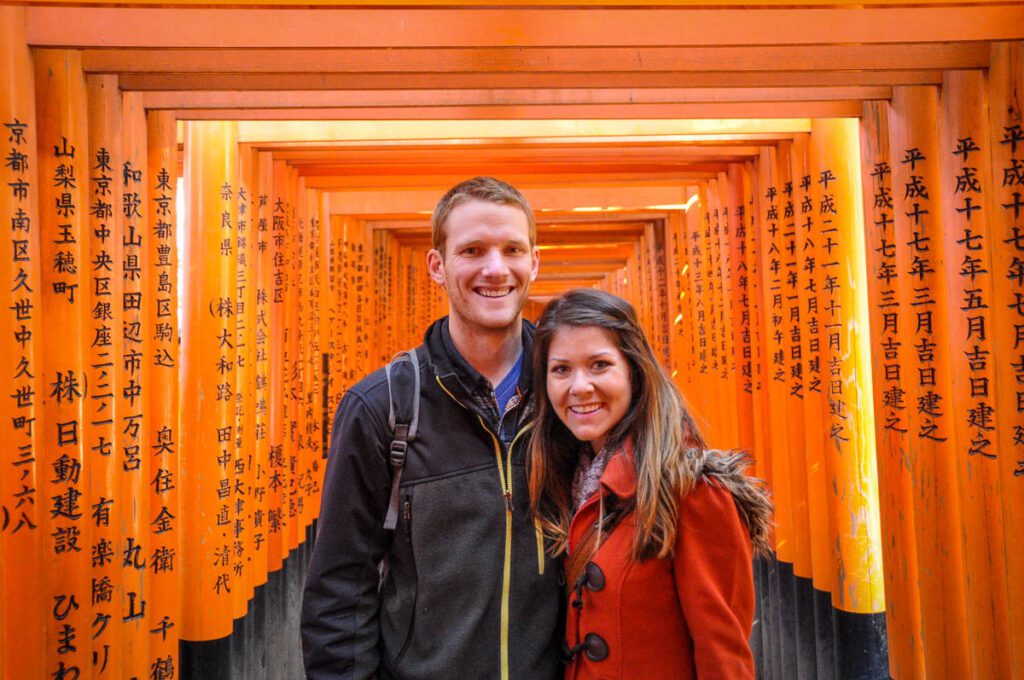
This comes down to personal preference, but here are some things to consider:
- Wear something you’ll be comfortable walking up stairs in. Long dresses or skirts can be a bit tricky (I know from personal experience!).
- This is a sacred area, so dress modestly.
- For photos that pop, avoid wearing reds and oranges (I made that mistake on one of my visits!).
- Wear layers that you can easily shed if you get too hot.
- If rain is forecast, you may want either a raincoat or an umbrella.
Before you leave, be sure to check out these super helpful guides full of packing hacks and tips for traveling in Japan that you won’t find anywhere else:
- Our Japan packing guide lists all the essentials (many of which you might not think about), as well as what you should NOT pack for a trip to Japan.
- This article on what to wear in Japan will help you create a perfect capsule wardrobe for every season and let you in on some cultural taboos so you can be sure to dress appropriately.
- With this FREE Japan packing list PDF download, we’ll send checklists straight to your inbox for everything from clothing and toiletries (for both women and men!) to what shoes to pack and extra stuff you may want to have on-hand just in case. Click the image below to get your free copy!

Where to eat nearby
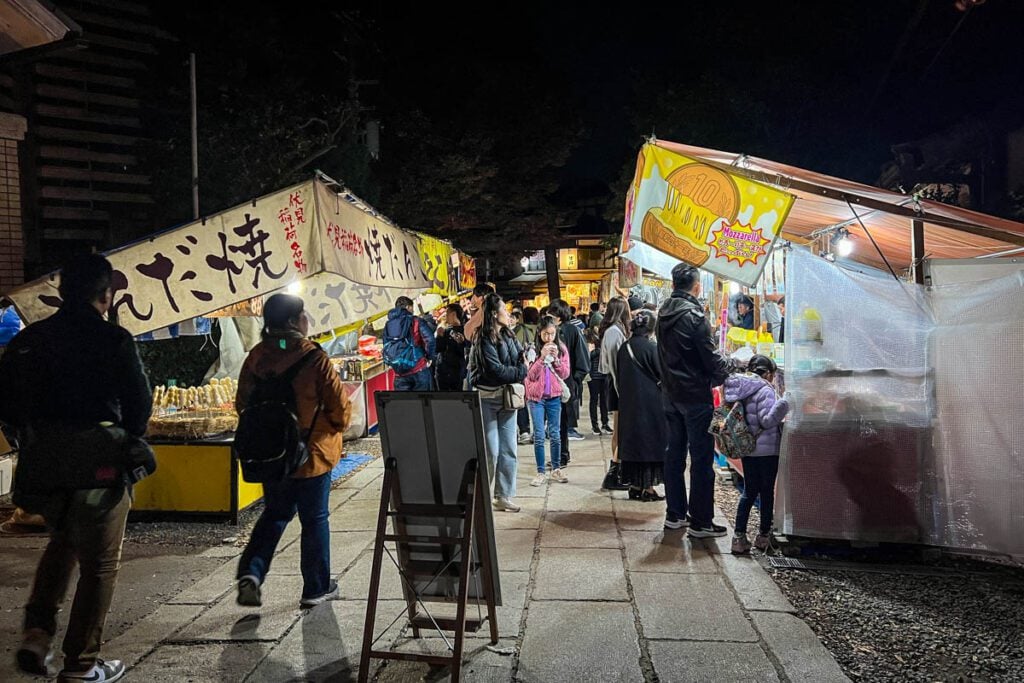
After doing the Fushimi Inari hike, you’ll likely have worked up quite the appetite. Lucky for you, there are a handful of food options near Fushimi Inari.
- Street food: Located on this small street not far from the entrance, there are lots of food stands selling all sorts of street foods, from takoyaki to potato spirals to wagyu on a stick to trendy cheese-filled pastries shaped like yen coins.
- Vermillion Cafe: If you visited Fushimi Inari in the early morning, this is the best place to go nearby for breakfast. Open from 9 a.m. to 3:30 p.m., you can enjoy artisan coffee, classic breakfast dishes, and even vegan options on their terrace that’s surrounded by trees and overlooks a small creek. If you have a sweet tooth, be sure to order the matcha ganache! Be warned, this is a popular place and it does get busy.
- Amazake shop: For an authentic, off the beaten path experience, pop over to this small shop where the owner serves amazake (sweet sake) with ginger. You can order it hot or cold, depending on what you’re feeling!
- Teuchi-udon Kendonya: This cozy shop is known for handmade noodles and a signature broth that’ll hit the spot after hiking Fushimi Inari on a chilly day.
- Kyoto Shoryu or Fukakusa Ramen Toriton: For a solid bowl of ramen, there are two shops that are both a short walk from the JR station and serve up comforting bowls of steamy noodles.
Fushimi Inari FAQs
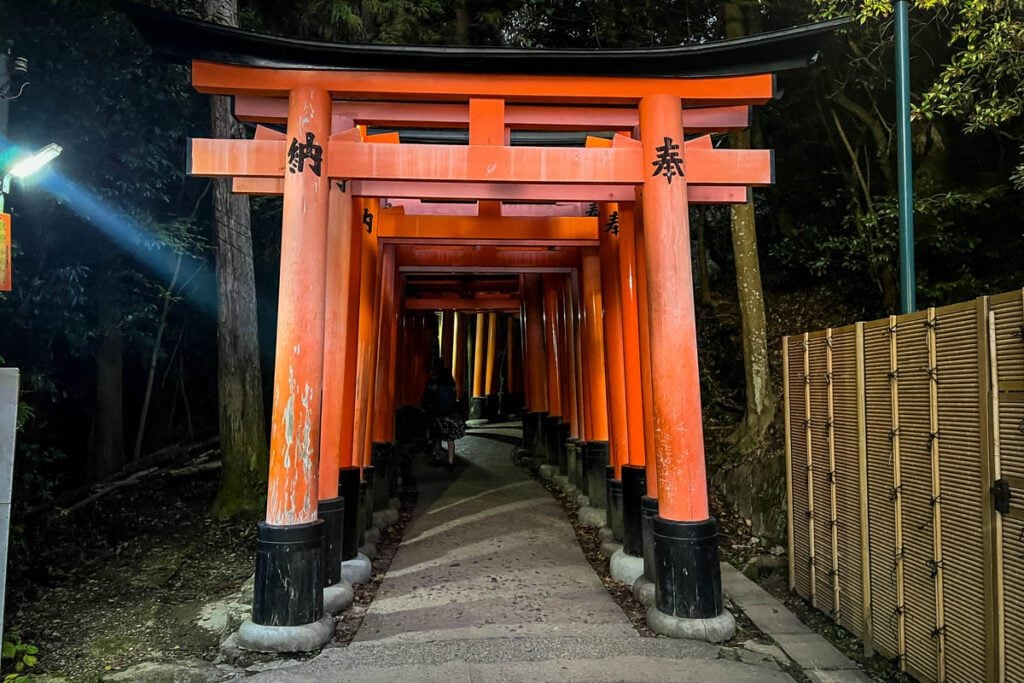
Still have questions about planning your visit to Fushimi Inari Shrine? We’ve got answers!
How much does it cost to visit Fushimi Inari?
It is completely free to visit Fushimi Inari. There is no entrance fee, making Fushimi Inari one of the best free things to do in Kyoto.
If you are taking the train, you can expect to pay roughly ¥150 for a ticket from Kyoto Station. You may also want to get a snack afterwards or a souvenir from the shrine.
What are the opening hours?
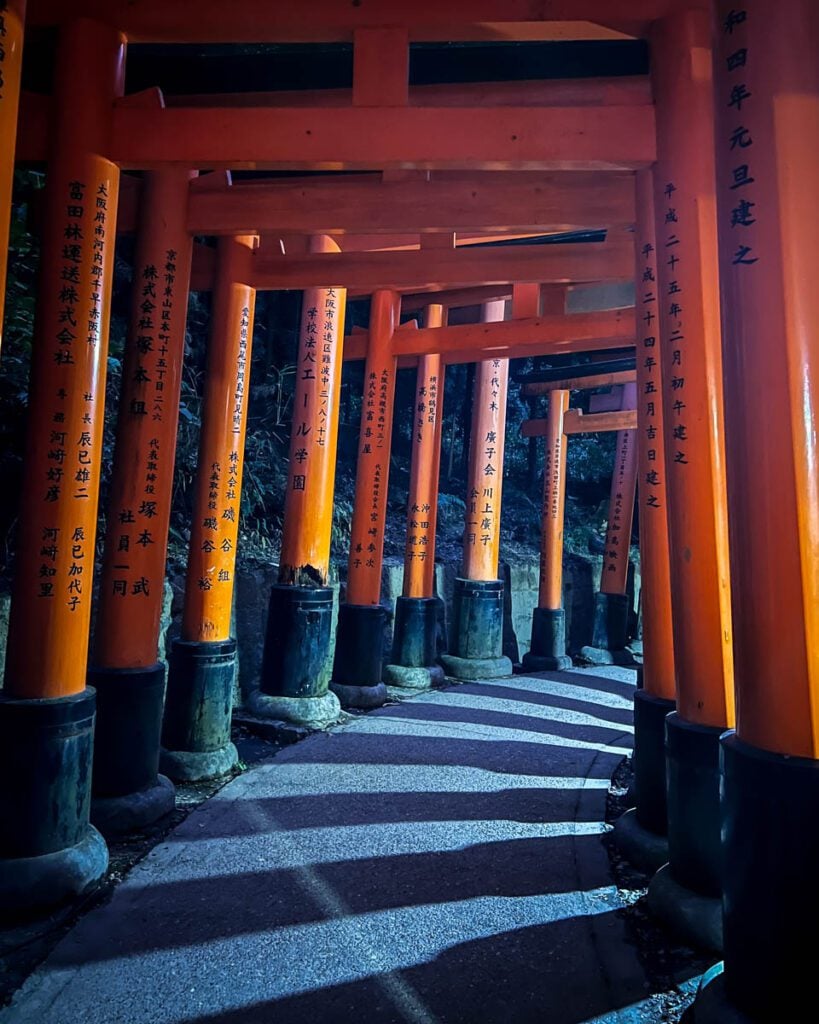
Fushimi Inari is open 24/7. This means it never closes and you can visit whenever you’d like.
That said, the trains in Kyoto generally run from 5 a.m. to 11 p.m., so it will be difficult to get here when they are not operating if you’re relying on public transportation.
How long do I need?
We’d recommend giving yourself 2-3 hours.
We’d lean toward the latter if possible, as this will allow you to hike to the summit, take your time, and maybe even grab something to eat in the area after you’re done.
How many torii gates are at Fushimi Inari?
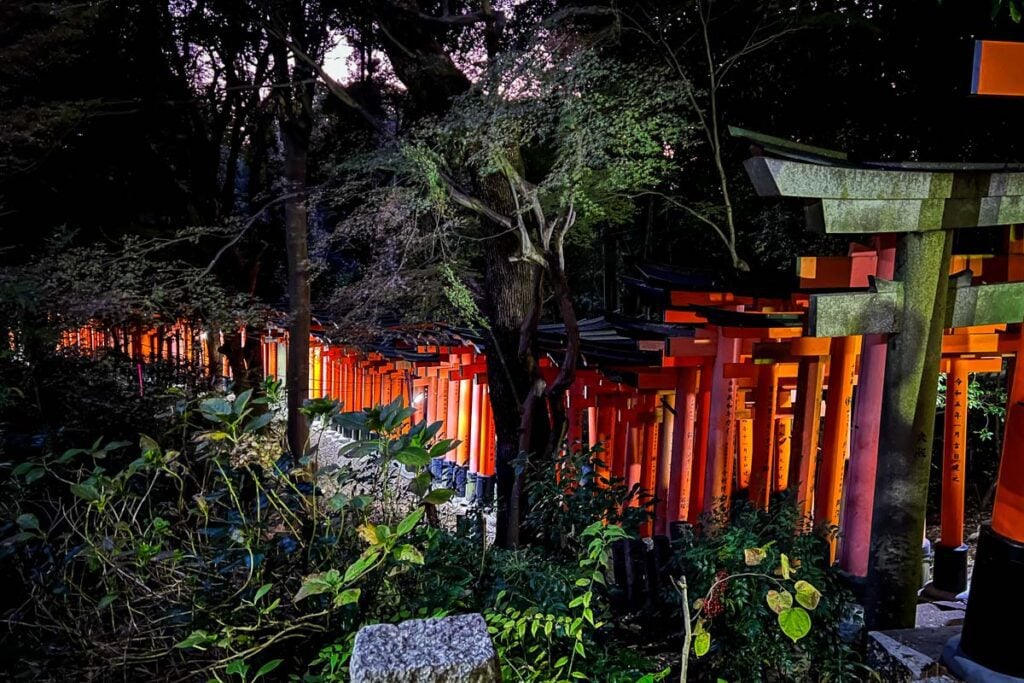
There are roughly 10,000 torii gates at Fushimi Inari.
How crowded is Fushimi Inari?
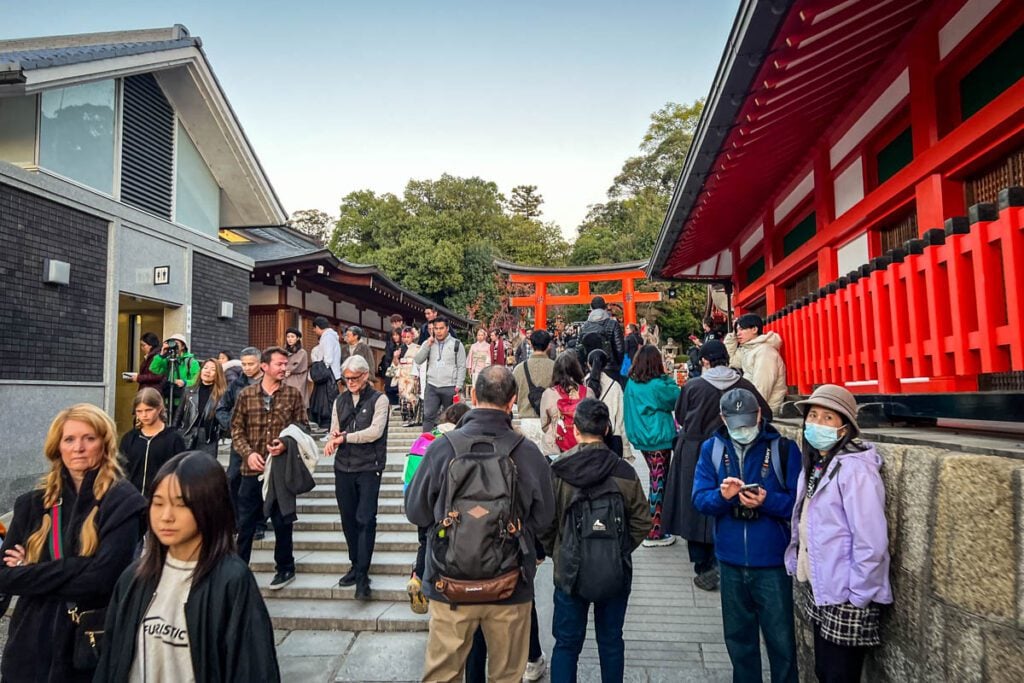
Yes, Fushimi Inari gets crowded daily. That said, there are definitely ways you can avoid the hordes.
For the best experience, we’d recommend being very mindful about the time of day you visit (go in the early morning or at night), and we would advise you to walk as far as possible on the trails because the crowds get significantly thinner the further you go.
How difficult is the hike?
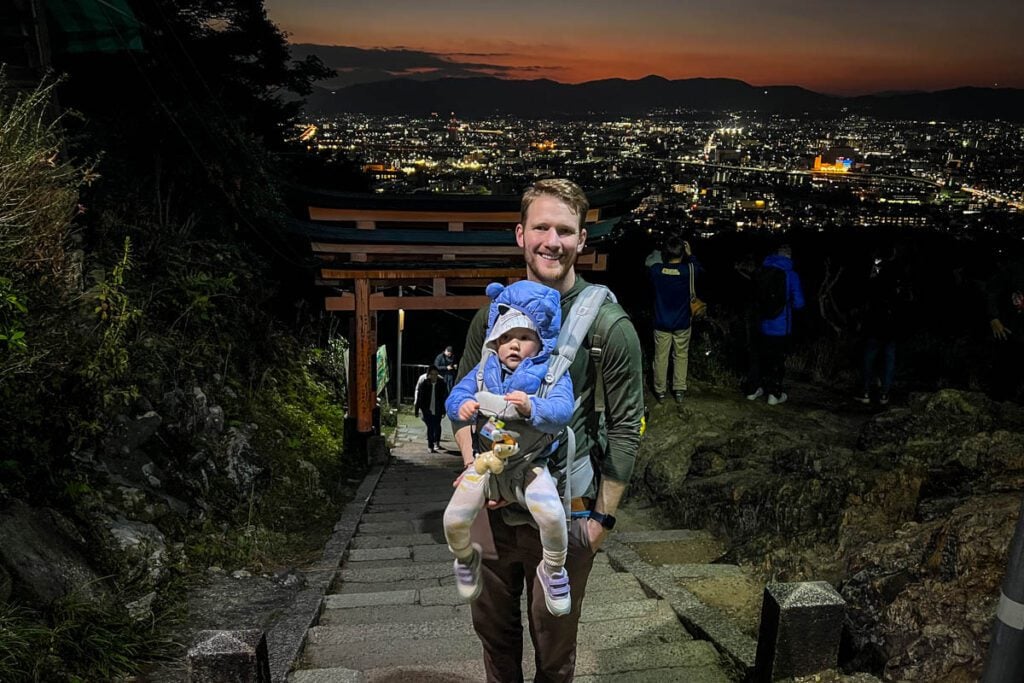
While this is a subjective question, we personally don’t think this is very difficult.
We do a lot of hiking, so the uphill climb may feel more difficult if you’re not an avid hiker.
However, overall it’s not that long or steep and you can turn around as soon as you’ve had enough.
Are there toilets on the trail?
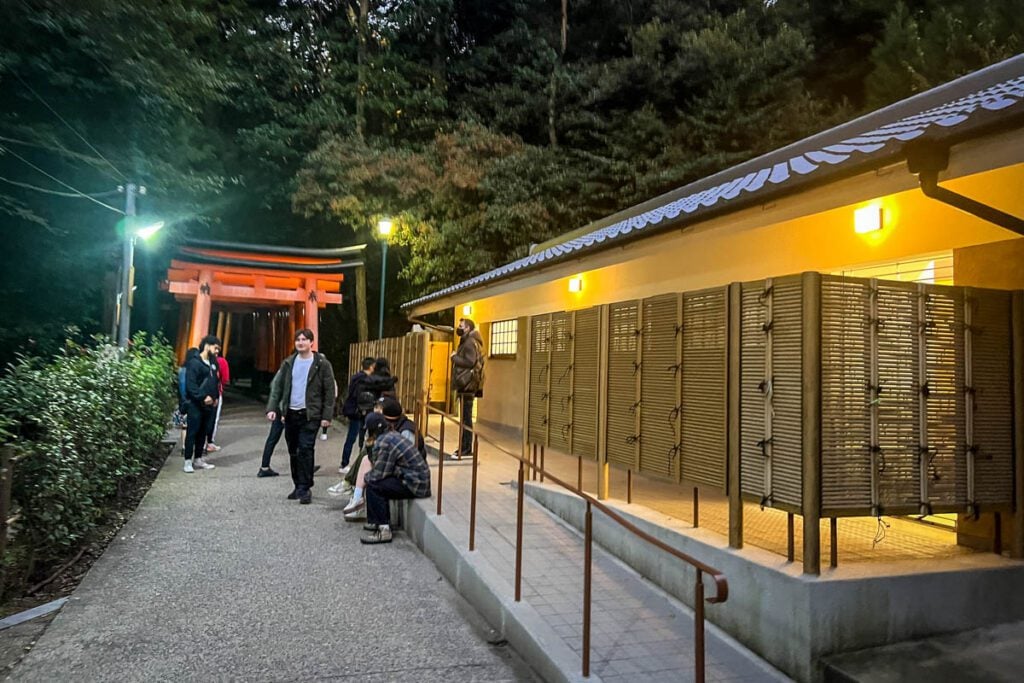
Yes, there are toilets at the entrance as well as four restrooms along the trail.
They are very basic, and they aren’t all that close together. For this reason, we’d recommend using the toilet at the entrance so you hopefully won’t have to use any of the others.
Is Fushimi Inari worth visiting?
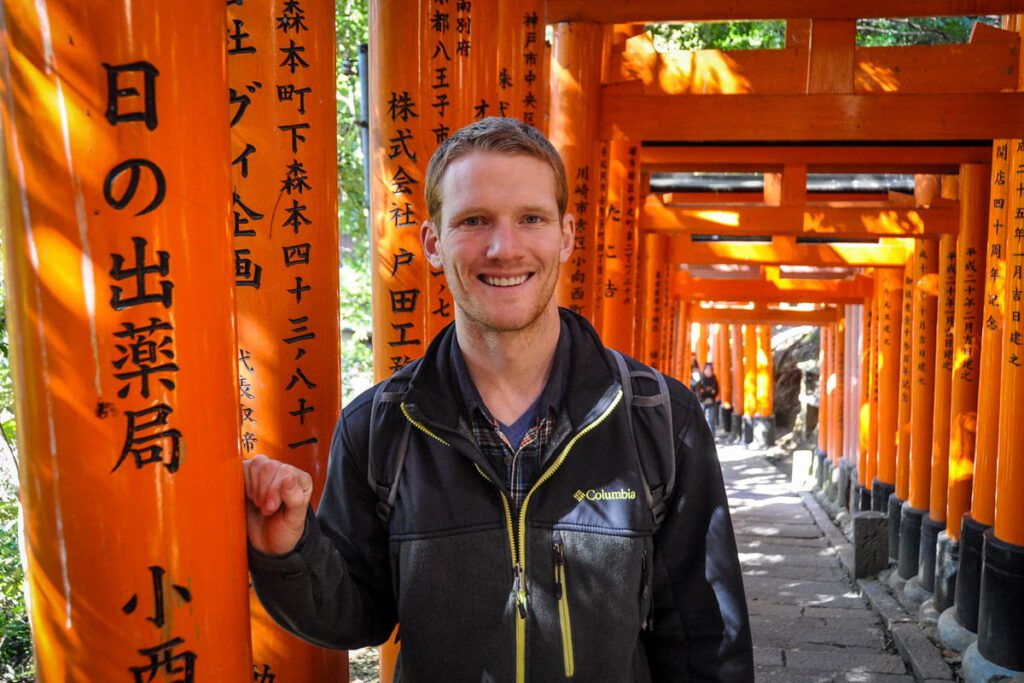
Absolutely, 100% yes!
Even though we’d already been once, we made sure to go again on our most recent trip to Japan. And it likely won’t be our last visit.
This is one of those attractions that lives up to the hype.
Is there wildlife along the trail?
We didn’t personally see any wildlife, other than some stray cats hanging out by one of the restaurants, but we’ve heard some people run into wild boars (especially when hiking Fushimi Inari at night). They shouldn’t be dangerous if you don’t provoke them, so we wouldn’t be worried.
Is this child friendly?
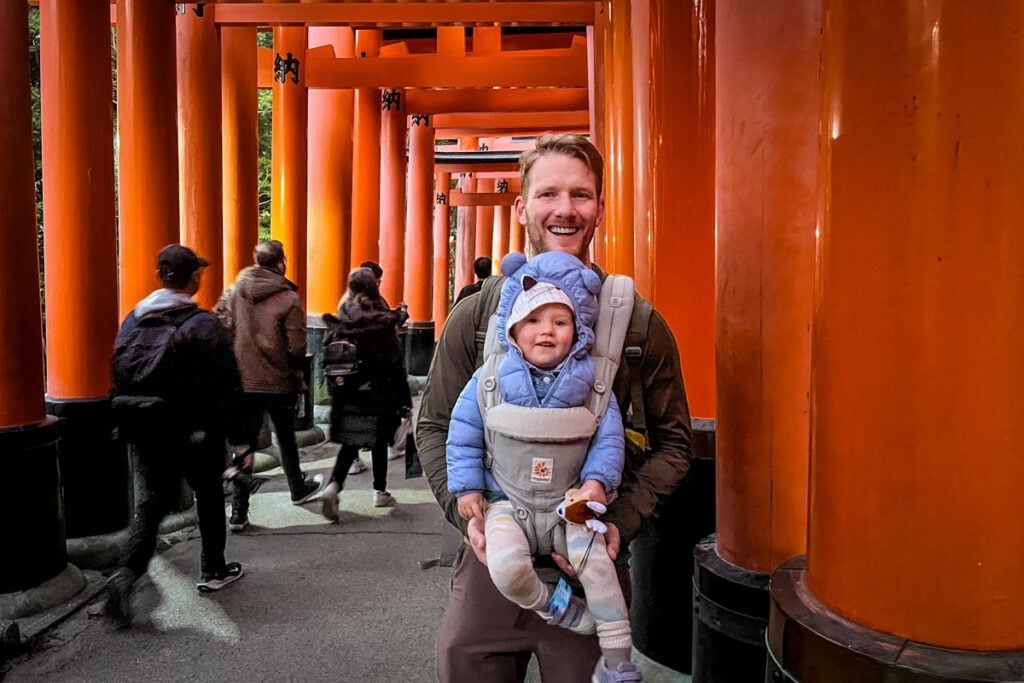
Yes, we think Fushimi Inari Taisha is child friendly! Of course, this always comes with a disclaimer that you know your child best.
Will they be keen on walking up lots of steps? The good news is you can go as far as you’d like and then turn around if they aren’t into it.
That said, we think many young kids would love walking through these brightly colored gates. Plus, we think spotting all the foxes could be a really fun game to keep a little one interested.
Personal experience: We brought our 2-year-old daughter to Fushimi Inari and she did great. She was at an age where she wanted to walk part of the time, so we went slow for a bit (which can be tricky when there are lots of people around). But we carried her for the most part and pointed out all the cool things to look at.
Psst! We have a whole guide dedicated to traveling in Japan with kids that is full of useful information (and encouragement!) for your trip.
Can I bring a stroller?

No, you will not want to bring a stroller on the Fushimi Inari hike (unless you want to carry it the entire way up!).
The good news is that there is a free stroller “parking lot” (also for bikes) near the entrance. Look for signs along the path.
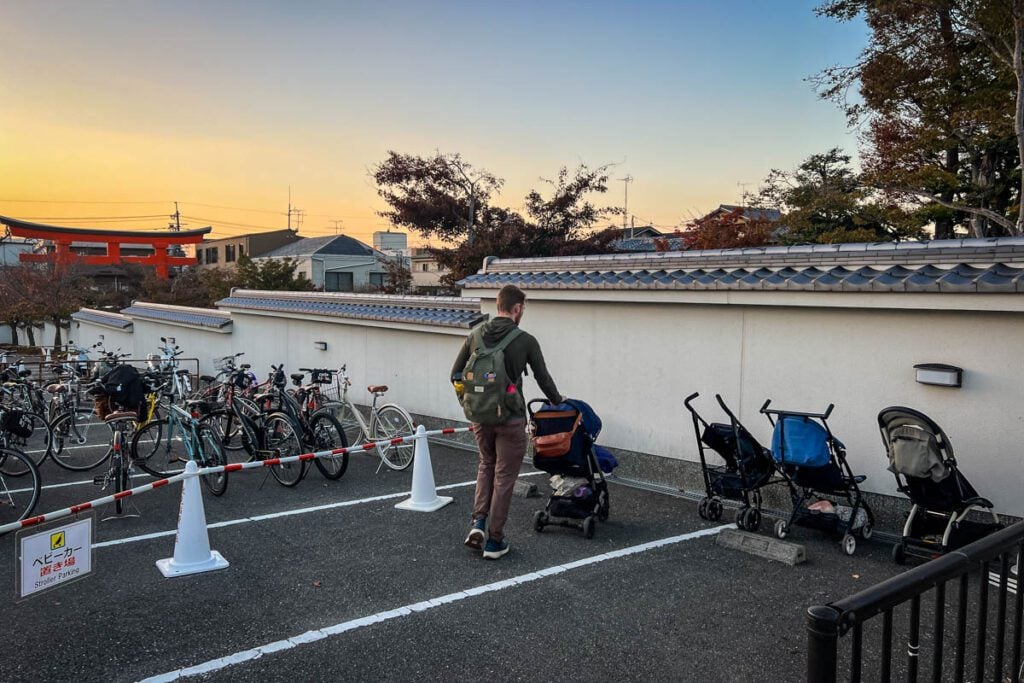
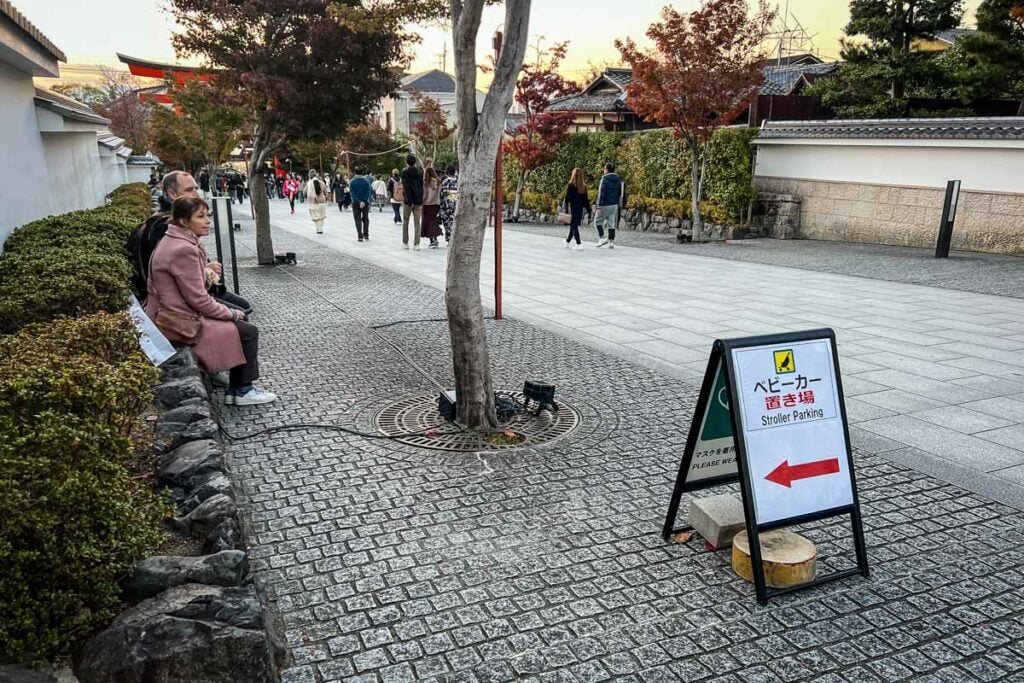
This was very helpful since we used our stroller earlier in the day and had it with us but didn’t want to bring it along on the hike.
Instead, we strapped on our Ergobaby Omni 360 carrier, which worked great!
Japan is an extremely safe country, so we had no qualms about leaving our stroller. That said, you shouldn’t leave any valuable items in your stroller in case a foreign traveler (much more likely than a Japanese person) were to want to take it.
Can I do this as a guided tour?
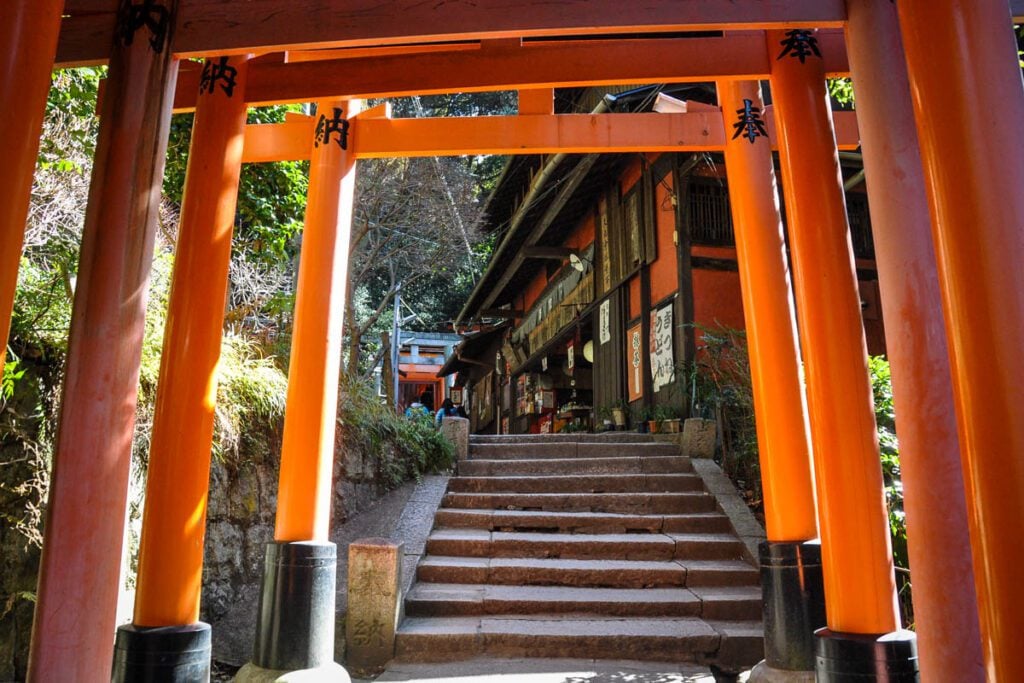
You sure can!
Personally, we think this is very easy to do independently so you can go at your own pace. This is what most people do (including ourselves).
However, if you enjoy guided tours and want to learn even more about this sacred place, a guided tour could be a good choice for you.
Here are two we’d recommend:
- This small group guided tour earns rave reviews and brings visitors off the beaten path of Fushimi Inari and to hidden bamboo groves that most visitors never see. (If that one is fully booked, this one looks very similar.)
- This private tour includes a visit to Fushimi Inari as well as other top Kyoto attractions, such as Ginkaku-ji Temple and Nishiki Market, and can be modified to include places you’re interested in seeing.
Where to stay in Kyoto
Hotel Imagine: This is where we personally stayed and think it’s a great spot especially if you’re traveling with kids as the rooms are incredibly spacious and well-laid-out and is conveniently located very close to the train station.
100 Year old Machiya Guest House: This charming guest house transports you back in time with its tatami interior and traditional Japanese garden onsite. Enjoy peace and stillness while still being close to many shops, stalls, and sites in Kyoto.
Hotel Resol Kyoto Kawaramachi Sanjo: This 3-star hotel is situated in the center of Kyoto and conveniently located next to the train station. Steps away are many popular shopping and dining areas, as well as popular Kyoto attractions.
Plan your trip to Japan
After 3 trips (and counting!), we’ve fallen head over heels for Japan—and we’ve created TONS of resources to help you plan your dream trip. Start with our Ultimate Japan Travel Guide and be sure to check out these helpful articles:
- First time? Our Japan Trip Planner walks you through everything you need to know.
- Use our Japan Rail Pass guide to determine if getting a train pass is optimal for your trip.
- Here’s our curated list of the best things to do in Japan—from iconic sights to once-in-a-lifetime experiences.
- Not sure where to go? Our Japan itinerary ideas will help you map it all out.
- Foodies, rejoice! This guide to what to eat in Japan will have you drooling before you land.
- This guide to what to wear in Japan (and what not to wear) will help you blend in.
- Use our ultimate Japan Packing List to make sure you don’t forget anything.
- Before you go, brush up on these essential Japan travel tips (including major do’s and don’ts!).
- Avoid awkward moments by brushing up on Japanese etiquette.
Still have questions? Drop us a comment—we LOVE helping travelers plan unforgettable trips to Japan!
Want to save time and energy on planning?
We’ve spent hundreds of hours (no joke!) researching for our 3 different trips to Japan, and we’ve been able to explore a lot of what this country has to offer!
We’ve compiled our experience to create the perfect trip for adventurous travelers that want to see iconic sights and hidden gems in the beautiful city of Kyoto, Japan.
This done-for-you itinerary is everything you need with 4 fully planned interchangeable days!
Just click the banner to get your Kyoto itinerary today!
Don’t miss your chance to grab our Kyoto map!
Get our custom Kyoto map sent straight to your phone! We loaded this map with all our favorite restaurants, sights, hidden gems, and more, so you can make the most of your time in Kyoto.
Just enter your email and we’ll immediately send you access instructions!
Save this article on Pinterest for later!
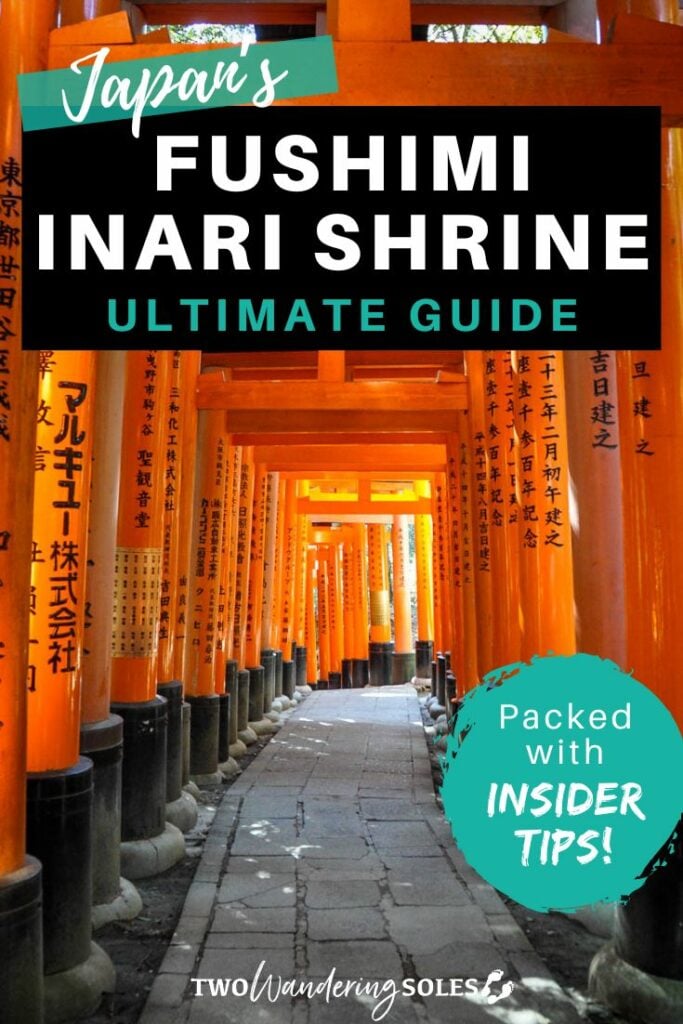

We want to hear from you!
Have you ever visited Fushimi Inari Taisha? How was your experience? Do you have any more questions or tips for us? Let us know in the comments below and we’ll do our best to get back to you!


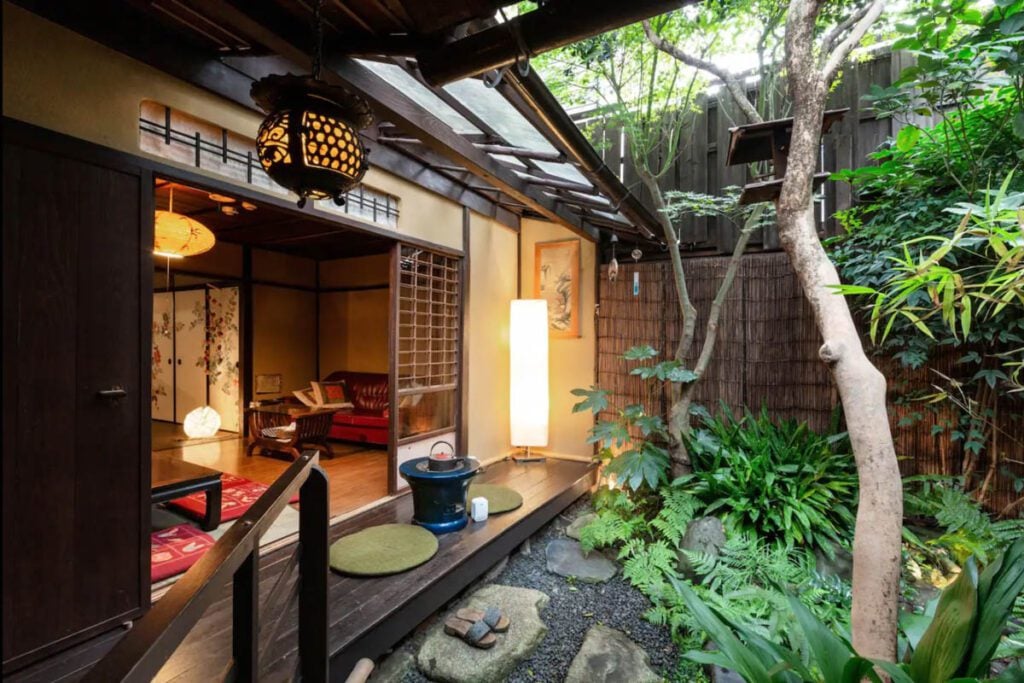

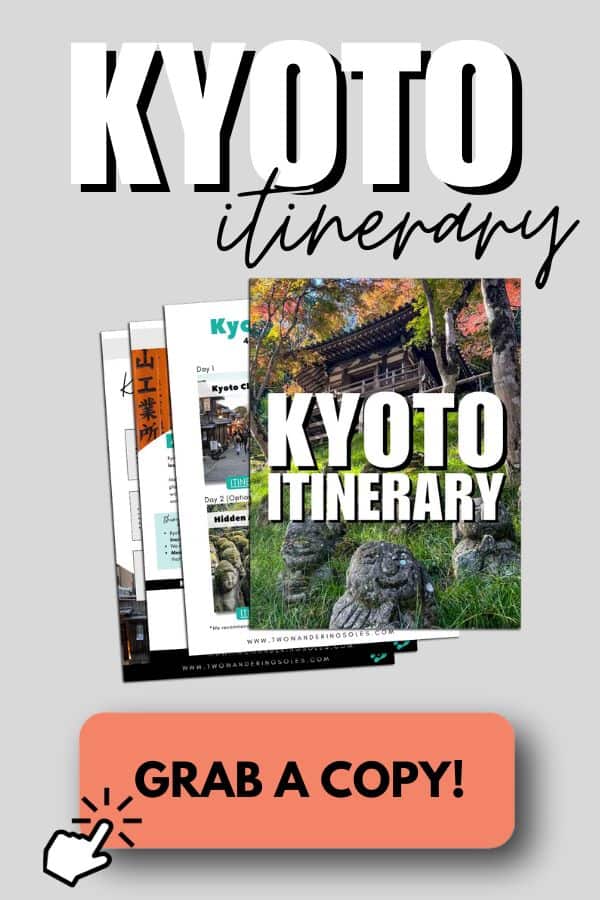
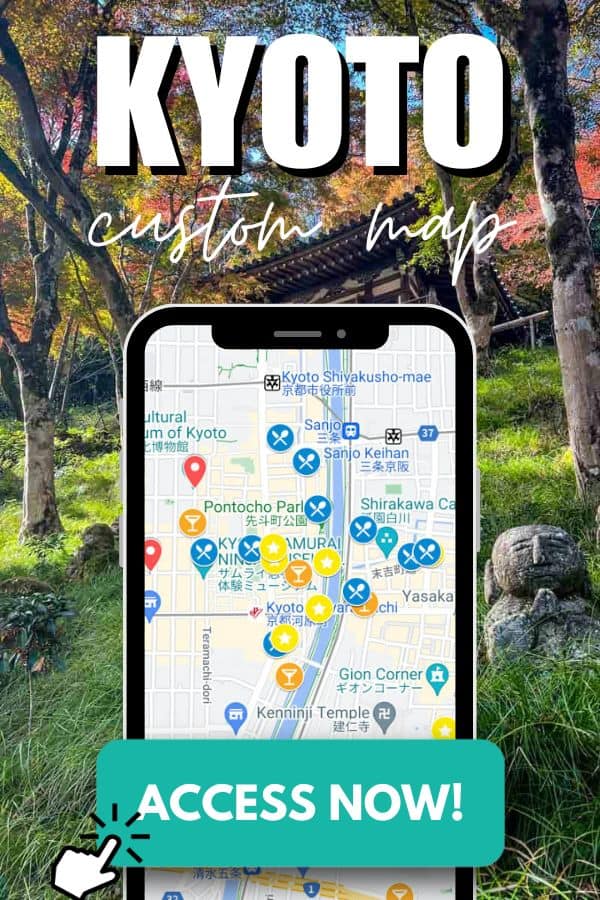
Can you enter in via one of the side trails, to avoid the initial crowded area? We’re happy to catch a taxi to a different entry / starting point. Even better if the taxi can take us to a higher elevation / eliminate some uphill.